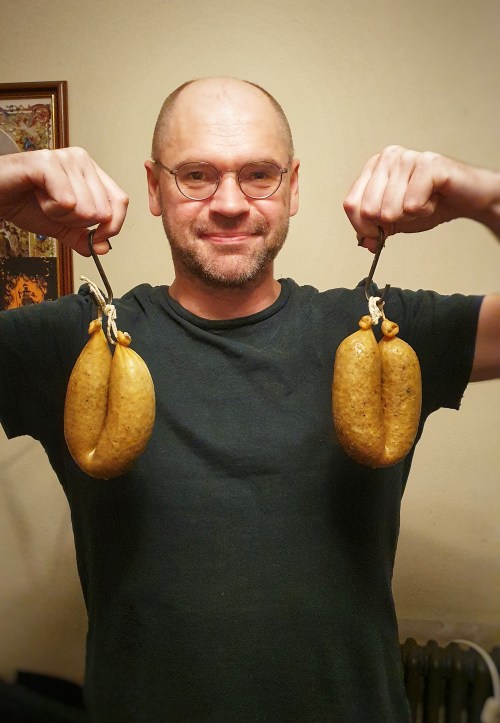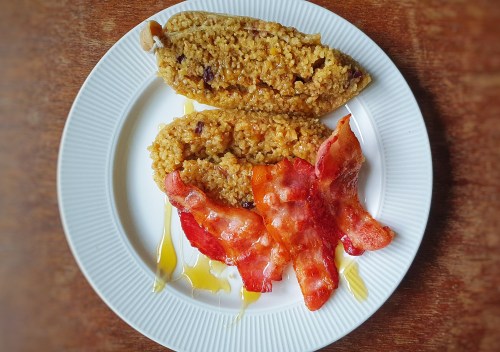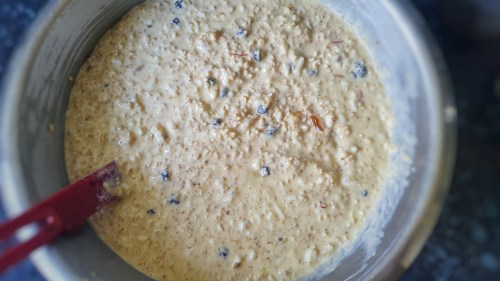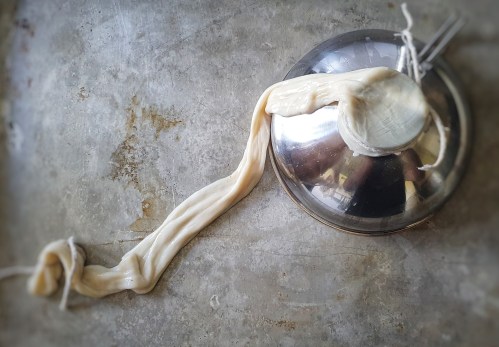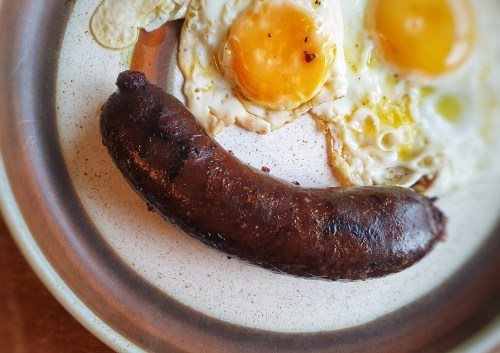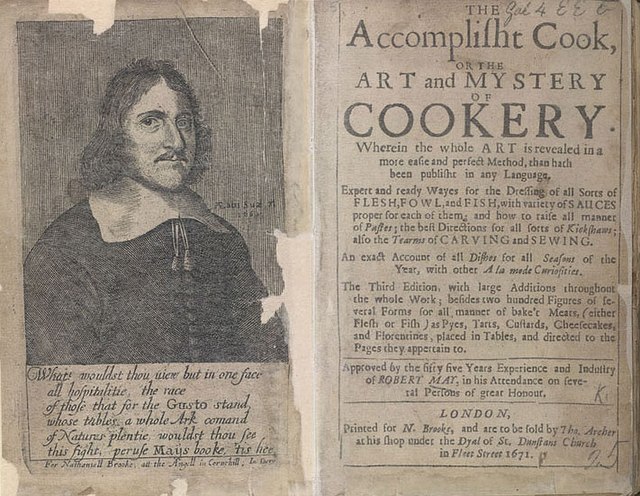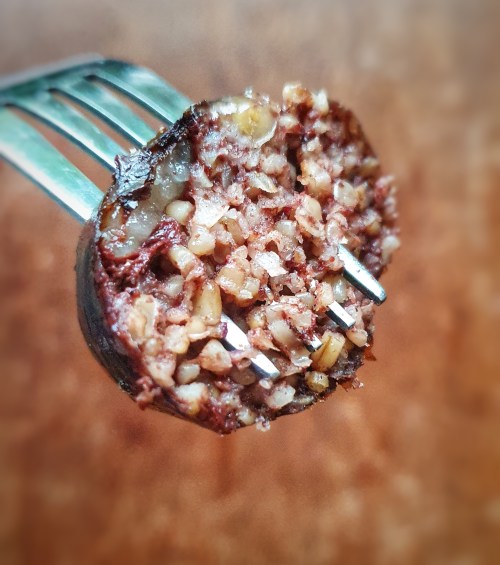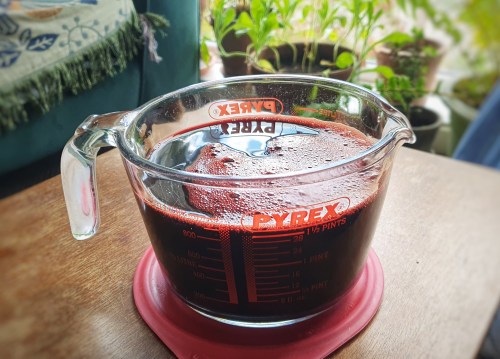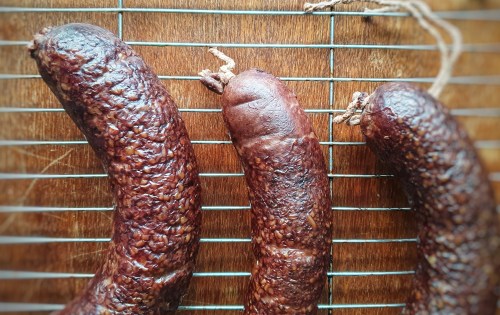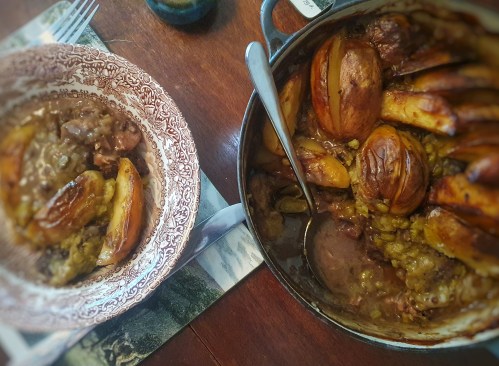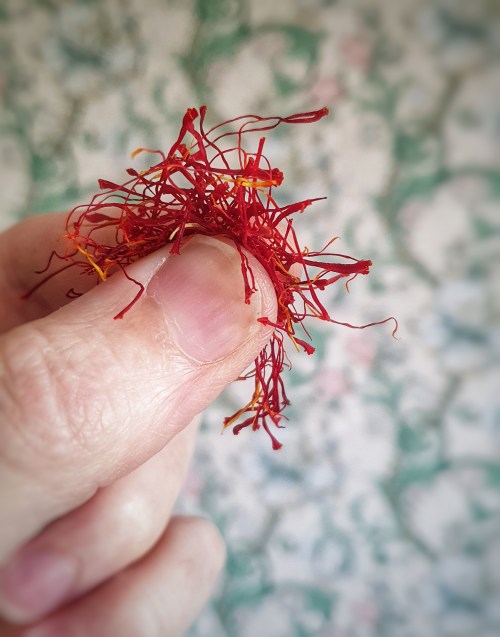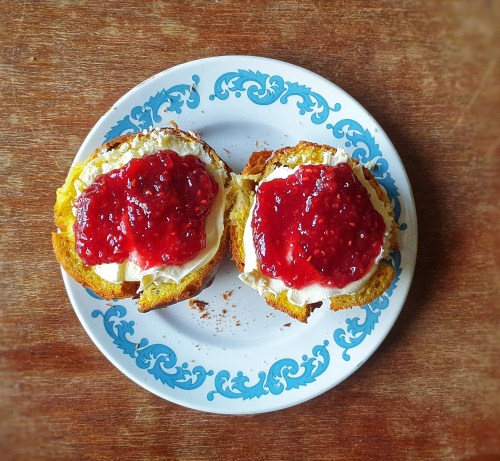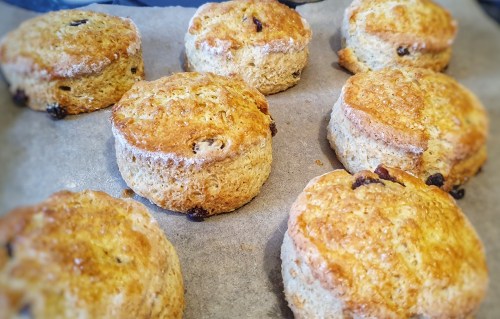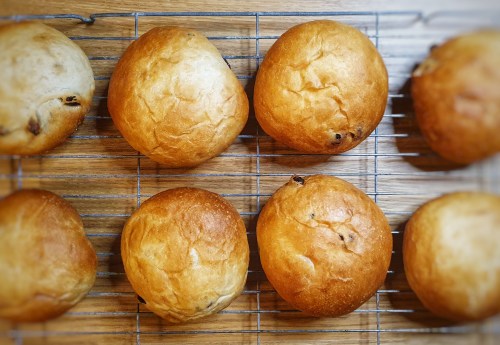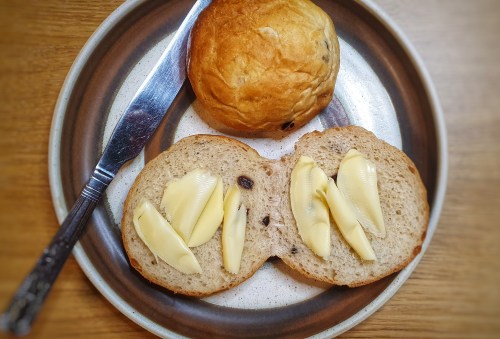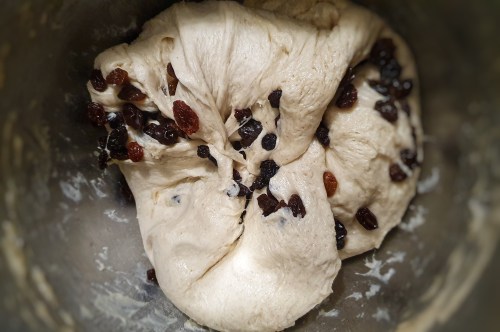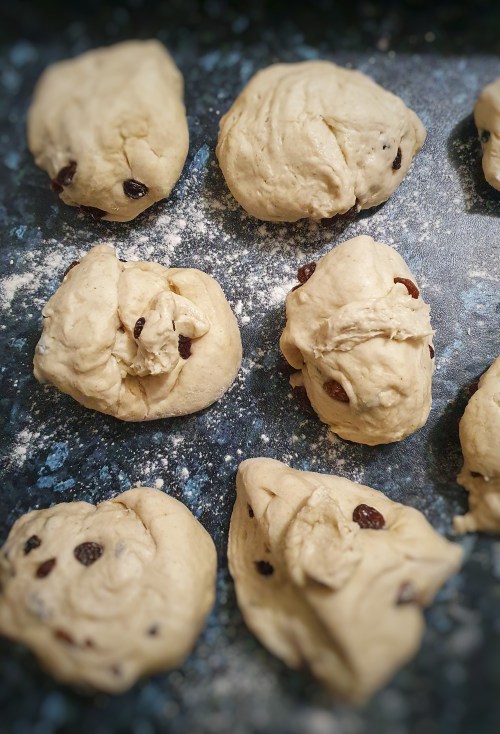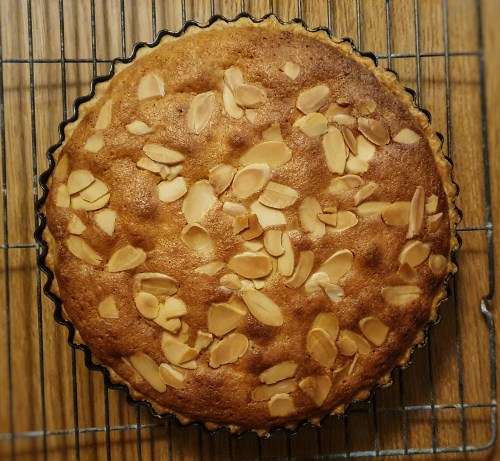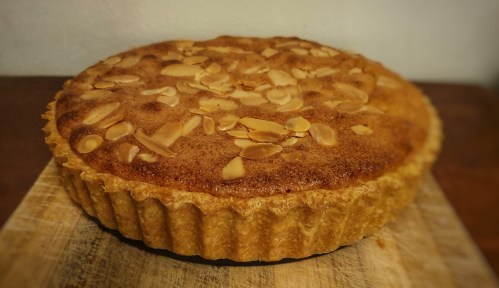Hello! I thought some of you might be interested in a post I just published on the other blog, Neil Cooks Grigson.
Category Archives: Recipes
Junket
Subscribe to get access
Read more of this content when you subscribe today. A monthly subscription costs just £3 (about $3.80 USD). You get access to premium blog content, the secret podcast, the Easter eggs page (with hours of clips to listen to!) and my monthly newsletter. For more information and to sign up, go to the Support the Blog & Podcast tab. Thank you
White Pudding
I recently had a go at making a fresh blood black pudding, taking inspiration from cookery books from the 16th and 17th centuries. The fresh blood was very kindly sent to me by Matthew Cockin and Grant Harper of Fruitpig, Britain’s last craft producer of fresh blood black pudding, who are also sponsoring the ninth season of The British Food History Podcast. Listen to the episode we recorded here:
We also talked about their hog’s pudding – a type of white pudding – and I felt I had to complete the set and make an Early Modern white pudding as well.
We know where we stand with black puddings: we expect them to be made largely of blood, cereal and fat, but what about white puddings? These are more mysterious, I feel. Modern white puddings are made from ground pork, pork fat, breadcrumbs and rusk or oats, plus lashings of white pepper, and are today associated largely with Scotland and Ireland. There used to be a rich diversity of white puddings right across Britain and Ireland, their contents highly variable, the only prerequisite being that the finished product would come out white. In the Early Modern Period, they were lavish ‘puddings of the privileged’[1], and had more in common with French boudin blanc than modern British white puddings. There was plenty of eggs, milk and cream, and the meat used (if any) was suitably pale in colour: Kenelm Digby’s recipe contained the meat of ‘a good fleshly Capon’ as well as streaky bacon,[2] Thomas Dawson’s was made with a calf’s chauldron, i.e. intestines.[3] Some recipes contain no meat at all: rice pudding could be counted as a form of white pudding in this context. Things do begin to get confusing, however, because some white puddings made with pork are called hog’s puddings, but only some. As Peter Brears wrote in an article on white and hog’s puddings:
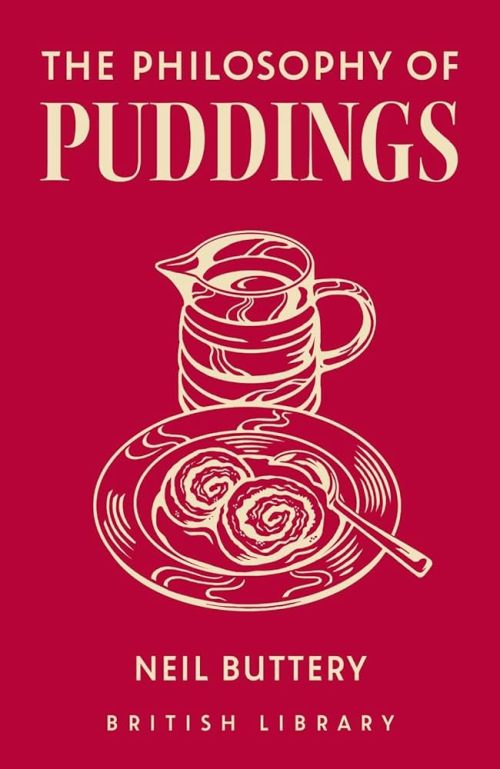
On studying these recipes, one rather surprising fact becomes particularly obvious; there is no material significance in the various names given to such puddings. Whether called hog’s or white puddings, their ingredients might be identical, or quite disparate, while many contain absolutely no pork whatsoever.[4]
Today, hog’s puddings are associated with Devon and Cornwall. Fruitpig’s hog’s pudding uses a base of bacon and oats. We can muddy the water even further because a hog’s/white pudding if made with pig’s liver could also go by the name of leverage pudding.
After a great deal of flicking through cookery books, I decided to make Gervase Markham’s white pudding from his classic The English Housewife (first published 1615), mainly because I had most of the ingredients in the house.
As you can see, Markham’s recipe contains no meat (aside from the beef suet and the pudding casings themselves).[5]
I have to say, they were a triumph! They freeze well and are easy to reheat. When it comes to serving them, let them cool for 5 minutes before cutting into them. The best way I have discovered to eat them (so far) is with crispy smoked bacon and golden syrup. Breakfast of champions.
If you like the blogs and podcast I produce, please consider treating me to a virtual coffee or pint, or even a £3 monthly subscription: follow this link for more information.
Recipe
Makes 6 x 375 g (approx.) puddings:
500 g cracked oat groats or pinhead oatmeal (steel-cut oats)
500 ml whole milk, plus 2 tbs for the saffron (and possibly extra, see recipe)
Around 2.5 metres of beef casings
600 ml whipping or double cream
150 g suet
130 g caster sugar
2 whole eggs plus 4 egg yolks
60 g sliced dates
60 g currants
¼ tsp ground black pepper
1/8 tsp ground cloves
¼ tsp ground mace
2 tsp salt
A 2-finger pinch of saffron
The day before you want to make your puddings, place the oats in a bowl or jar and pour over the milk. Cover and refrigerate. Soak your beef casings in fresh water, cover and refrigerate too.
Next day make the pudding mixture: in a large mixing bowl add the milk-soaked oats, cream, suet, sugar, eggs, dates, currants, ground spices and salt. Stir well. Warm up the 2 tbs of milk, add the saffron strands and allow them to infuse and cool, then stir into the mixture.
Now let everything meld together for a couple of hours so that the whole mixture is the consistency of spoonable porridge. If your oats were particularly absorbent, you may need to loosen the mixture with a few tablespoons of extra milk.
Cut the soaked beef casings into 35 cm lengths and tie the ends securely with string. Now it’s time to attach a funnel to the other end of your first length of gut. I used a jam funnel and secured it with more string.
Hold the funnel in one hand and add small ladlefuls of mixture into the gut. It should slip down relatively easily. Keep the funnel raised and try to massage out any large air bubbles. When the gut is around two-thirds to one-quarter full, remove the end tied to the funnel, press out any air and tie with more string. The casings are slippery and so you must make sure that the knots are made at least 2.5 cm/1 inch from the ends. I found 350 g mixture to be a good amount. Now tie the ends together with more string to make that classic pudding shape.


Keep them covered as you get a large pot of water simmering.
Cook the puddings in batches: drop three into the water and let them gently poach for 35 minutes – there should just be the odd bubble and gurgle coming from the cooking water. You must pop any bubbles immediately with a pin, otherwise the puddings will burst open. Turn the puddings over every 7 or 8 minutes to make sure both sides are cooked evenly.
When cooked, fish the puddings out and hang them up to dry for a few hours, then refrigerate.
To cook the puddings, poach them in more water for around 15 minutes, turning occasionally.
[1] Davison, J. (2015). English Sausages. Prospect Books.
[2] Digby, K. (1669). The Closet of Sir Kenelm Digby Opened (1997 reprint) (J. Stevenson & P. Davidson, Eds.). Prospect Books.
[3] Dawson, T. (1596). The Good Housewife’s Jewel (1996 Editi). Southover Press.
[4] Brears, P. (2016). Hog’s Puddings and White Puddings. Petits Propos Culinaires, 106, 69–81.
[5] This recipe is from the 1633 edition: Markham, G. (1633). Country Contentments, or The English Huswife. J. Harison.
Filed under Britain, cooking, food, General, history, Puddings, Recipes, Seventeenth Century, Uncategorized
A Recipe for Early Modern Black Puddings
For years now, I have wanted to make my own fresh blood black puddings, but fresh blood is so tricky to get hold of in Britain, I thought I would never get the opportunity. Lucky for me then, that Fruit Pig, who are sponsoring the ninth season of The British Food History Podcast, kindly sent me a litre of pig’s blood. When it came to recipes, I very much had my eye on Early Modern black puddings because they seem so outlandish compared to traditional black puddings of today. On one hand, they are very British, containing oatmeal and/or breadcrumbs and plenty of chopped beef suet. On the other, they are reminiscent of a French boudin noir in that there are lashings of cream and egg yolks.
There are lots of unexpected herbs and spices, too. Thomas Dawson uses sheep’s blood, milk-soaked oats, suet and what we might think of as the constituents of a mixed spice today: nutmeg, mace, black pepper, ginger and cinnamon.[1] Sir Kenelm Digby liked to use chicken blood, cream, almond cream, bone marrow, sugar, salt, rosewater and eggs.[2] Robert May gives us some precise pointers as well as several ways of making black puddings. In one recipe he combines blood and cream in a ratio of 2:1. Sometimes he soaks oats in milk, sometimes blood: ‘Steep great oatmeal in eight pints of warm goose blood, sheeps blood, calves, or lambs, or fawns blood’. He uses a whole range of interesting herbs, including thyme, spinach, parsley, sorrel and strawberry leaves, to name but a few. He also adds ‘Sometimes for variety, Sugar, Currans, &c.’[3] I really want to know what sweet black pudding tastes like!
Using these descriptions as inspiration, I created the recipe below. There was a certain amount of trial-and-error, and whenever I got stuck, I made sure to gain advice from Regula Ysewijn’s Pride and Pudding, Hugh Fearnley-Whittingstall’s The River Cottage Cookbook and Fergus Henderson’s The Complete Nose to Tail.[4]
I learned a great deal making them – the most important lesson being just how skilled one must be to make these sorts of puddings frequently and in large amounts. It made me appreciate even more the hard work of our forebears and Fruit Pig!
I was really surprised with how well the puddings turned out, and I would certainly recommend giving them a go. I made one batch with sugar and currants and one without. You might be surprised to hear that the sweet one was really quite delicious. I fried my savoury puddings and served them with fried eggs atop some sourdough toast. They tasted rich and were a cross between a black pudding and haggis. I’ll let you know how I served the sweet black puddings.
There are just a couple of things I would have done differently: my main issue was that the butcher gave me pigs’ casings which were not suitable for these black puddings – the nubbly pieces of oat tore through them easily, and the skin burst under their own weight at times. I would therefore recommend beef casings or simply baking them in the oven in loaf tins, or maybe even frying up blood pancakes as suggested by Regula Ysewijn![5]
If you can, support the podcast and blogs by becoming a £3 monthly subscriber, and unlock lots of premium content, including bonus blog posts and recipes, access to the easter eggs and the secret podcast, or treat me to a one-off virtual pint or coffee: click here.
Recipe
Makes approximately 12 x 20 cm black puddings if made in pork casings, and 6 x 20 cm puddings if made in beef casings.
600 g pinhead oats
Milk (see recipe)
1 tsp fennel seeds
½ tsp cloves
½ tsp black peppercorns
3 blades of mace
1 ½ tsp dried, mixed herbs
2 tsp salt
900 ml fresh pig’s blood (or reconstituted dried blood)
600 ml double cream
200 g chopped beef suet
2 whole eggs, beaten
140 g currants (optional)
320 g sugar (optional)
Natural pork or beef skins, soaked in water overnight (optional, see recipe)
The day before you want to make your puddings, place the oats in a bowl or large jug and pour in enough milk to just cover them. Place in the fridge overnight. Grind the spices and mix in the dried herbs and salt.
Next day, place all of the ingredients (aside from the casings, if using) in a large mixing bowl. Combine and allow everything to mingle, dissolve and absorb; around an hour – or more if you have the time.[6]

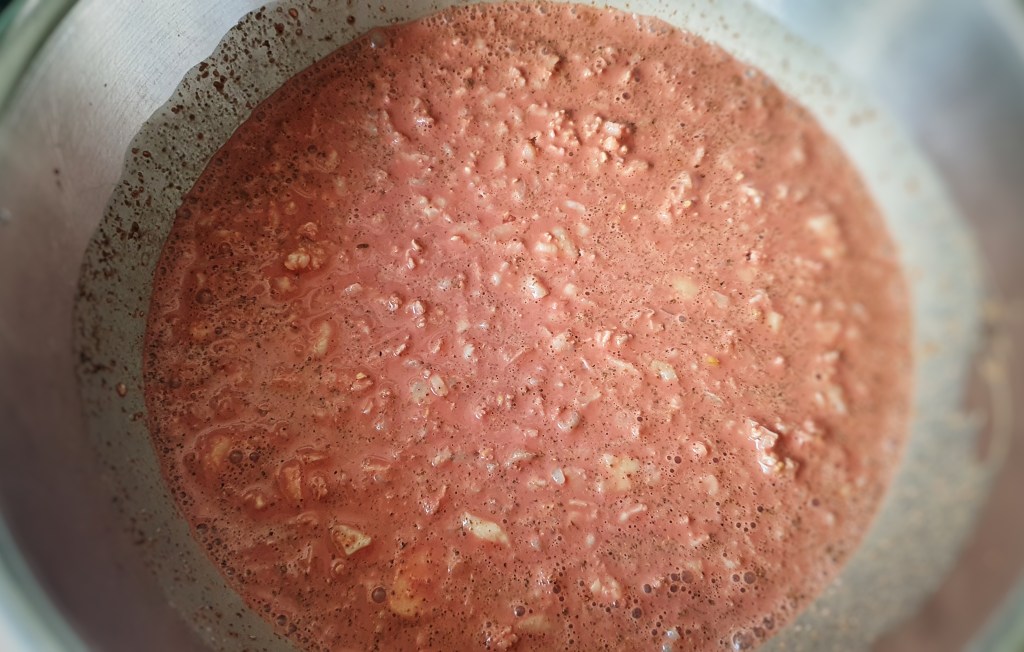

Once everything has had the chance to macerate and absorb, it is time to assemble the puddings. I used my sausage stuffer funnel from the Kitchen Aid and attached a length of pork casing onto it, then secured it with some string and knotted the end. Then I set about filling the casings, a spoon at a time, letting the skins naturally fill and fall into a bowl. Then I tied a link off with some string, making sure the casing wasn’t full and there were no obvious air bubbles. The lengths of the puddings were around 20 cm – though I wasn’t very consistent. In retrospect, I would recommend using beef casings tied to a wide-mouthed jam funnel, much easier to fill and no constant tearing.
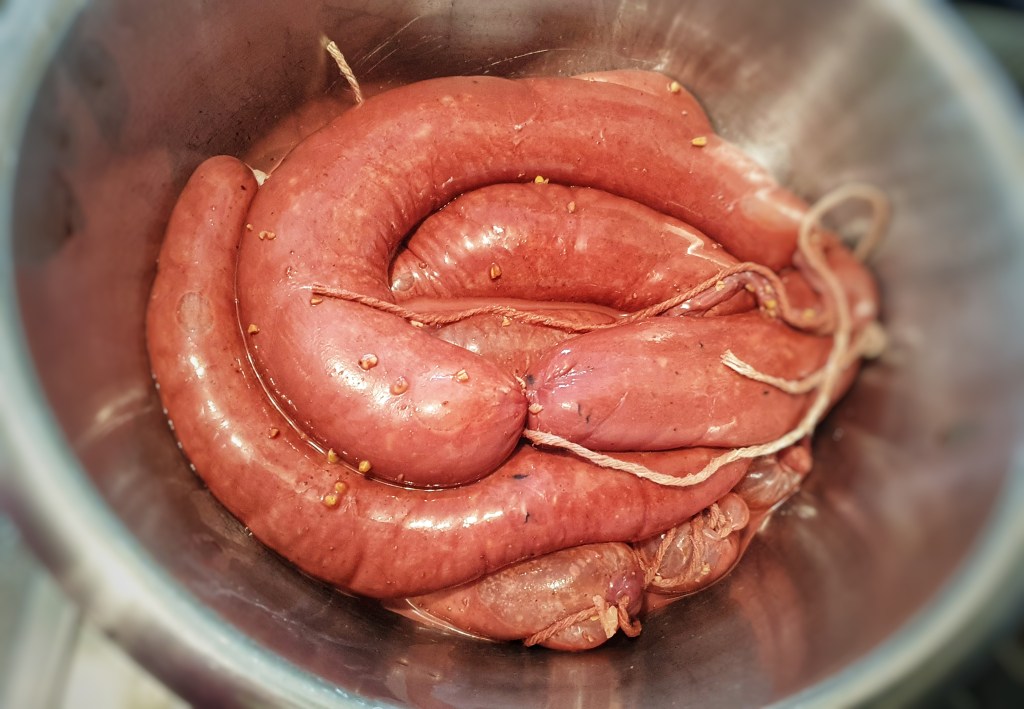
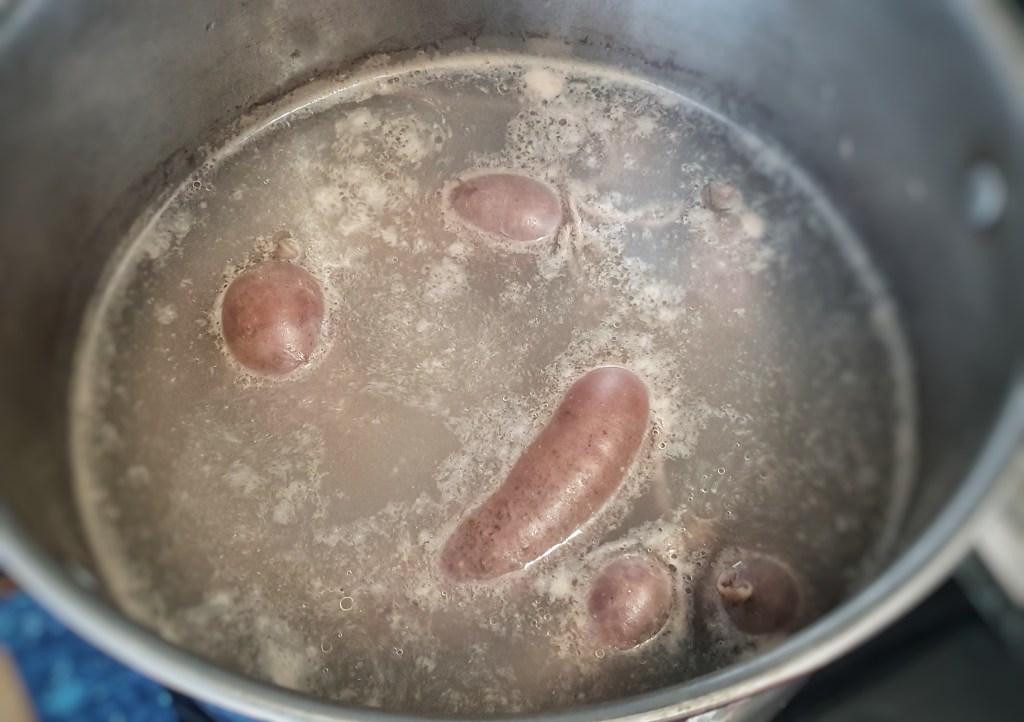
Once all of the mixture is used up, get a large pot of water to a good simmer and gingerly plop them in a few at a time. Three was a good number. Keep the water at a gentle simmer and arm yourself with a pin and pop any bubbles that appear in the cooking puds, lest they burst. They will take around 20 minutes to cook, and you must watch them like a hawk, pin poised and ready to pop. You can tell they are done when the liquid that comes out of a freshly-pricked pudding is clear. If using beef casings, they will take 30 to 35 minutes to cook.
Carefully remove the puddings and either hang them up or lay them on a cooling rack to dry for a few hours before placing them in the refrigerator.
You can avoid all of this faff by baking the mixture in large loaf tins sat in a bain-marie for around 1½ hours at 160°C.[7]
Notes
[1] Dawson, T. (1596). The Good Housewife’s Jewel (1996 Edition). Southover Press.
[2] Digby, K. (1669). The Closet of Sir Kenelm Digby Opened (1997 reprint) (J. Stevenson & P. Davidson, Eds.). Prospect Books.
[3] May, R. (2012). The Accomplisht Cook (1660/85) (A. Davidson, M. Bell, & T. Jaine, Eds.; 1685th ed.). Prospect Books.
[4] Fearnley-Whittingstall, H. (2001). The River Cottage Cookbook. Collins; Henderson, F. (2012). The Complete Nose to Tail: A Kind of British Cooking. Bloomsbury; Ysewijn, R. (2015). Pride and Pudding: The History of British Puddings Savoury and Sweet. Murdoch Books.
[5] Ysewijn (2015)
[6] Note: Looking back on these initial stages, it would have been much better to soak the oats in the blood overnight, mix everything together in the morning, let everything meld and mingle for a couple of hours, and then add enough milk to make a mixture of a spoonable porridge consistency. We live and learn.
[7] Note: I haven’t tested this method; these instructions have been extrapolated from the Fergus Henderson recipe for blood cake in Henderson (2012).
Cumbrian Tatie Pot (aka Cumberland or Westmorland Hotpot)
In my last post I launched the ninth season of The British Food History Podcast with an episode about Black and White Pudding with Matthew Cockin and Grant Harper (aka Fruit Pig). Not only are they the only remaining craft producer of fresh blood black puddings in Britain, but they are very kindly sponsoring this season of the podcast. Their puddings are exceptional, and Matthew and Grant are very kindly giving readers of the blog and listeners of the podcast 10% off at their online shop (www.fruitpig.co.uk) with the offer code Foodhis, so if you can please support them – if we don’t use producers like Fruit Pig, we will lose them, and that would be a terrible shame. It’s also worth checking with your local butcher – my nearest traditional butcher, Littlewood’s in Heaton Moor, Stockport, the very place where I bought the meat for today’s recipe, stock them – so perhaps yours does too (or you could suggest they do if they don’t!). Have a listen to the episode, if you haven’t already:
Now, I reckon the vast majority of black pudding eaters enjoy theirs as part of a fried breakfast, but I think we need to remember that black puddings can be eaten for any meal, and in the last post I detailed the old traditional way of eating them with mashed potato and apple sauce. Today I am going one better with this delicious and warming Cumbrian Tatie Pot, a hotpot made of lamb, beef and black pudding, pulses and onions, topped not with nice, neat round slices of potato like a Lancashire hotpot, but quartered floury potatoes.[1] It is important that the cheaper, tougher cuts of beef shin and lamb neck are used, and that the hotpot should be cooked long and slow.
The result is a rich and unctuous hotpot that sticks to your ribs and serves plenty of people; it was on the menu at The Buttery in the first year it was open, and it was very popular.[2] Well-flavoured meat cuts like shin and neck require a similarly good-flavoured black pudding like those made by Fruit Pig.
I first heard about this rather decadent one-pot dish from Jane Grigson in her book English Food.[3] I can find only a few other references to it – a regional dish that seems to be rarely cooked today, yet should, in my opinion, be much more popular than it is.
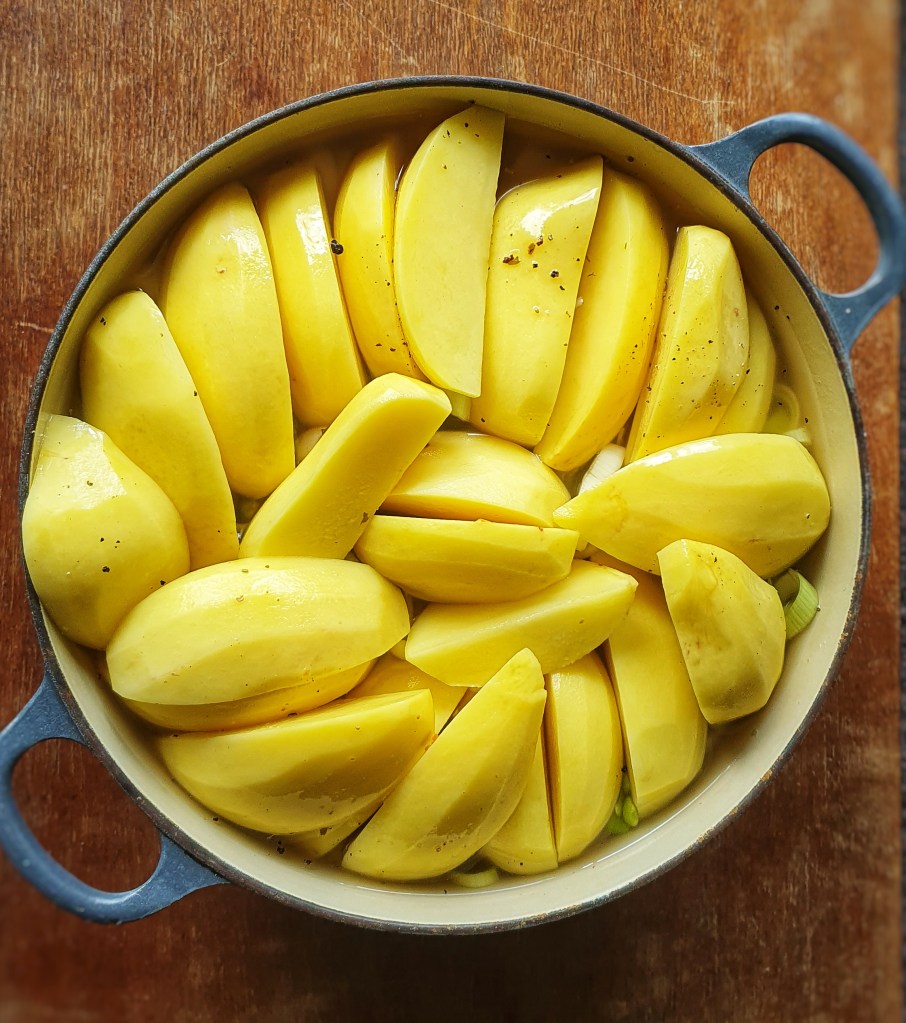
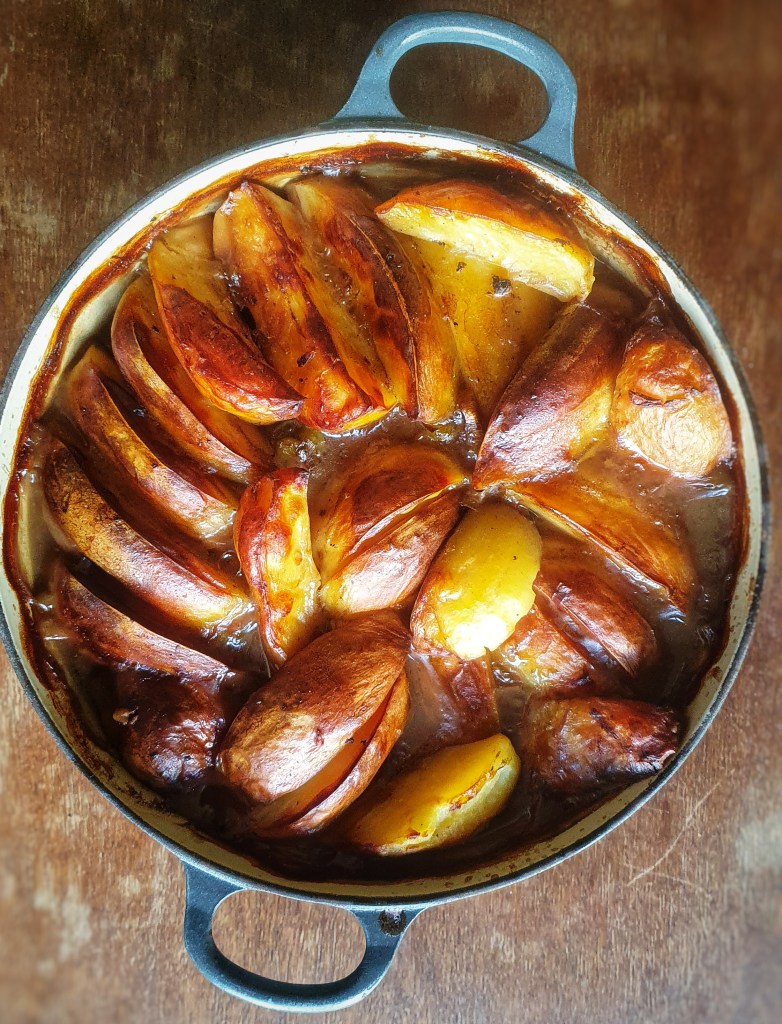
Jane was given the recipe from a Mrs Burrows, and in English Food, she tells us that ‘Mrs Burrows said that what interested her was that the tatie pot is one of our few dishes in which different meats are combined, something which is common in mainland Europe.’ Indeed, and assuming your black pudding contains pigs’ blood, then we have three species of mammal altogether; very rare indeed!
Jane Grigson points out that some recipes say that the beef is optional, ‘which it most definitely is not’, she writes, ‘[i]t makes the character of the dish.’ Looking at similar Lakeland recipes available on the Foods of England Project website, there are recipes that contain beef but not lamb (Westmorland tatie pot), and lamb but not beef (Cumberland hotpot). Neither contain pulses, and both have sliced potatoes nicely arranged on top like a Lancashire hotpot.[4] I’m not saying that Jane’s is right and others wrong; it is just interesting to me that everyone has their own correct version of a dish, possibly with slight geographical differences, and usually it’s the one you grew up with, the one that is most familiar to you, that is the ‘right’ one.
If you can, support the podcast and blogs by becoming a £3 monthly subscriber, and unlock lots of premium content, including bonus blog posts and recipes, access to the easter eggs and the secret podcast, or treat me to a one-off virtual pint or coffee: click here.
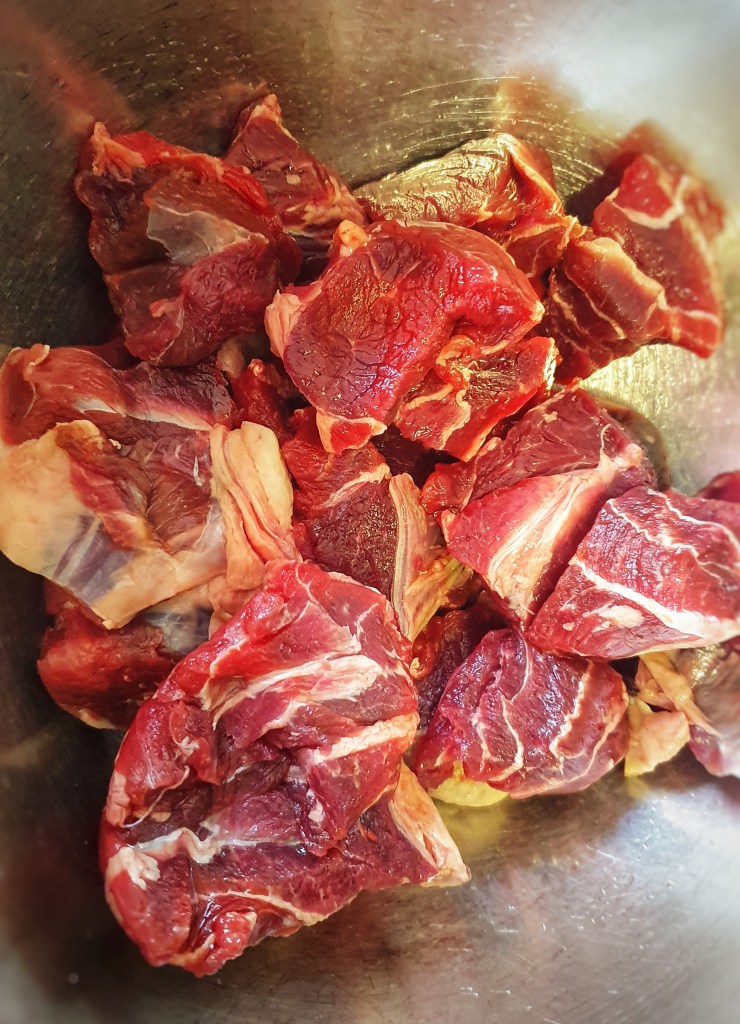

Recipe
The long cook time on this hotpot means that you need to keep the liquid levels topped up. You can use stock or water for this – there is nothing wrong with the latter when cooking with these robust cuts of meat.
Serves 8
4 tbs dried split peas or mixed pulses
750 g shin of beef
750 g lamb neck (‘scrag end’ of neck)
1 level tablespoon of cornflour
Salt and pepper
One 350 g Fruit Pig black pudding
2 onions, peeled and sliced, or 2 leeks, trimmed, rinsed and thinly sliced
Around 1.2 kg floury potatoes
Around 800 ml hot light beef, lamb, or chicken stock, or water
Soak the pulses in water overnight (or, if you are badly organised, soak in warm water for 4 or 5 hours).
Preheat your oven to 160°C. Shake the meat, cut into neat chunks, with the cornflour, and scatter the pieces over the base of a large casserole, season with salt and pepper, then tuck in slices of the black pudding. Sprinkle with the onions or leeks and the drained pulses. Peel the potatoes and slice them into quarters lengthways. Arrange the quarters on top; I find it is impossible to do this neatly. Pour over enough stock to go halfway up the potatoes and season them with more salt and pepper.
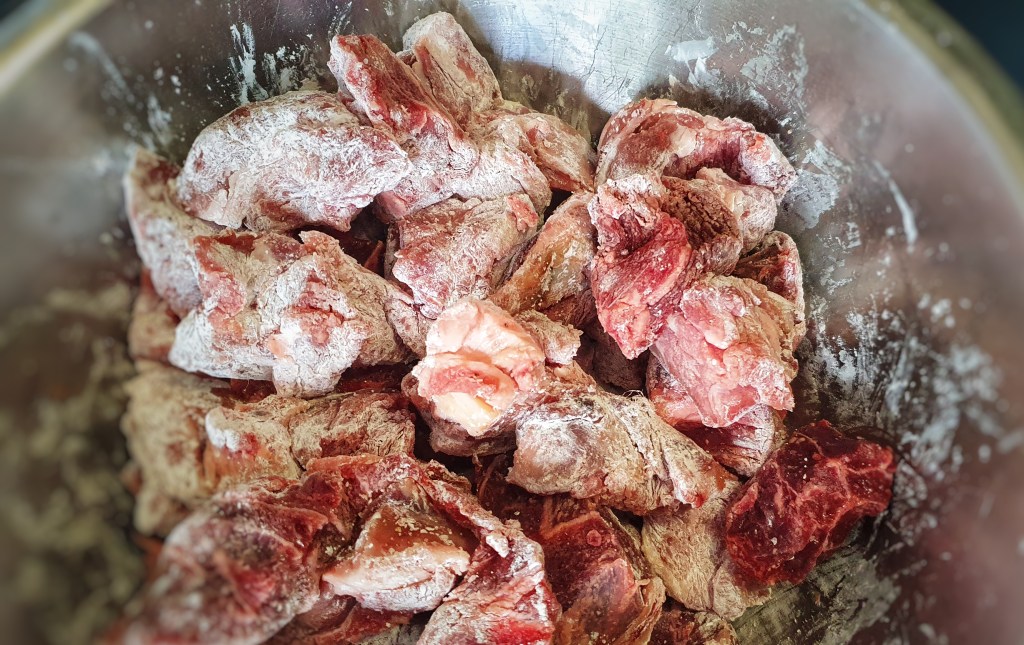
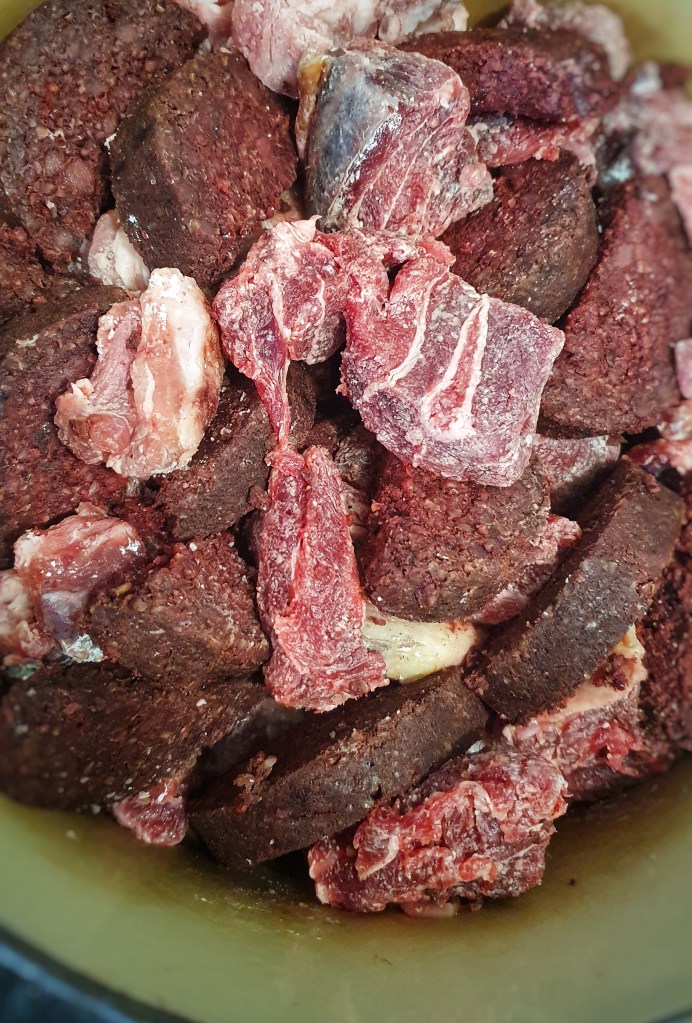
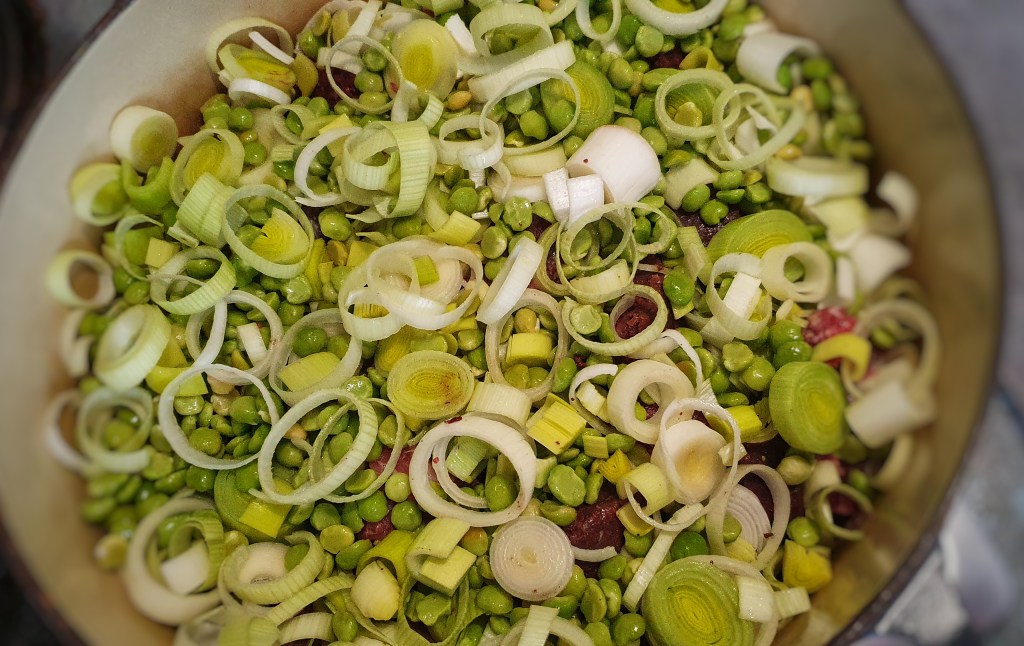
Bake for 4 hours, topping up with more stock or water every hour or so.
Serve with steamed green vegetables or braised red cabbage.
Notes:
[1] Grigson, J. (1992). English Food (Third Edit). Penguin.
[2] The Buttery was my bricks-and-mortar restaurant in Levenshulme, Manchester, open between 2016 and 2017, though it did exist as a pop up restaurant and artisan market stall before that.
[3] For those not in the know, I got into this traditional cookery and food history malarky because I cooked every recipe (well, almost every recipe) in Jane’s wonderful book. This was my first blog Neil Cooks Grigson. Hear about it in this podcast episode from season 8:
[4] Hughes, G. Tatie Pot. The Foods of England Project; https://foodsofengland.info/tatiepotorcumberlandhotpot.html.
Saffron Buns

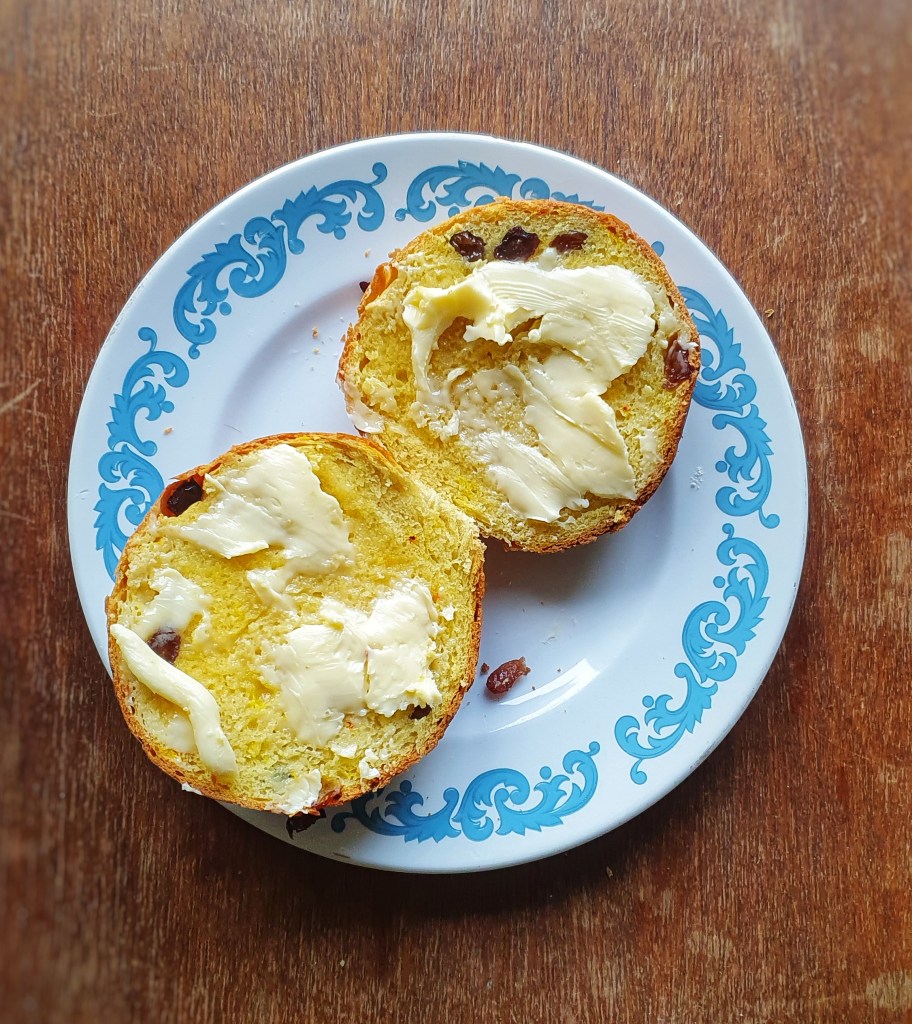
Saffron-scented buns, breads and cakes used to be enjoyed right across England from at least the 17th century. Today, however, they are typically found in bun form and are associated with Cornwall because, from around the 1780s, saffron was only grown in this area and Essex.[1]
A modern-day saffron bun is a lovely egg yolk yellow and has that lovely, unique earthy flavour associated with the spice. Other ingredients usually include mixed spice, dried fruit and a little sugar, and e enriched with a good amount of egg and clotted cream, though as Sam Bilton points out in Fool’s Gold: A History of British Saffron, Sarah Harrison’s 18th-century recipe contains no fruit, and the only spice used aside from saffron is coriander seed.[2] Early recipes are usually for single, large cakes such as Sir Kenelm Digby’s ‘excellent cake’, which is baked in a hoop and requires ‘a Peck of fine flower’. It’s enriched with (amongst other things) ‘one pint of Sack…half a pint of Rose-water [and] half a quarter of an ounce of Saffron.’ It is then iced with sugar and egg whites flavoured again with rose water.[3] Rosewater seems to have been a key ingredient because it’s still used a century later in John Farley’s London Art of Cookery (1783) and again in Cassell’s Dictionary of Food a century after that.[4] Perhaps it should be brought back?
Because of their expensive and rich ingredients, saffron buns are associated with celebrations and feast days. On Good Friday (a day associated with spiced buns), they were cut with a cross and brushed with a saffron wash and eaten with clotted cream.[5] At Christmastime, they were made into miniature cottage loaf shapes. They were also a special taste of home: folk of Newquay, when putting together Christmas food parcels to be sent to fighters during the Great War, were sure to include saffron cakes and buns.[6]
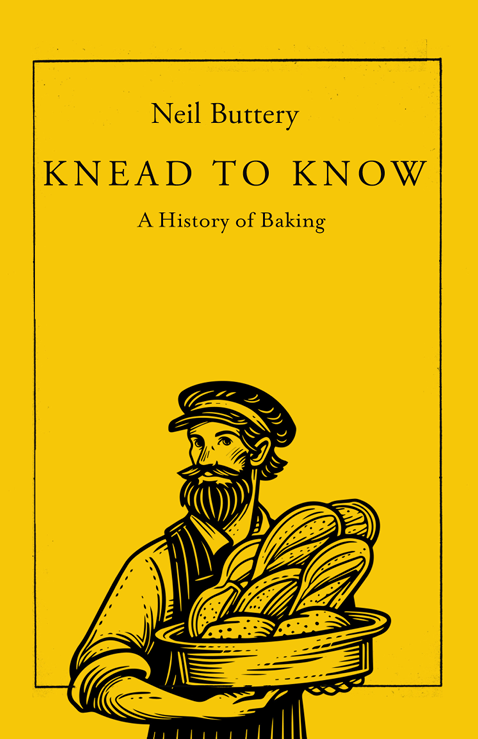
According to Cassell, aside from providing colour and flavour, saffron makes buns or cakes ‘wholesome and palatable’, aids digestion and will ‘drive out intestinal worms’ to boot, and suggests swapping the liquid used in your favourite bun or cake recipe for saffron-steeped hot water that has been allowed to cool to blood heat.[7]
Saffron is the most expensive spice in the world by weight, and there was (and still is) therefore pressure for food manufacturers to use an adulterant such as yellow food colouring or turmeric to offset costs. Real saffron buns are appropriately (but proportionally) more expensive than your regular fruit bun, and according to Elizabeth David, the strands are not strained from their soaking water as one might expect, ‘probably as a visible sign that true saffron has been used.’[8]
But how much saffron to use? Amounts can vary greatly, and Sam Bilton wrestles with this question: she spotted that Elizabeth David complained about people using too much saffron in their cooking – true, it can taste soapy when over-applied – but then asks for four pinches in her recipe for buns![9] Of course, the answer depends upon a few factors: the quality of your saffron, how long it has been sitting in the spice rack, and how much you enjoy the flavour of saffron. My recipe uses ‘a good 2-finger pinch’.
If you want to know more about the history of saffron in Britain, have a listen to this episode of The British Food History Podcast with guest Sam Bilton:
If you like the blogs and podcast I produce and would to start a £3 monthly subscription, or would like to treat me to virtual coffee or pint: follow this link for more information. Thank you.
Recipe
Makes 12 buns.
230 ml full-fat milk, plus extra for brushing.
A good 2-finger pinch of saffron
500 g strong white bread flour, plus extra for rolling
1 tsp/8 g instant yeast
1 tsp/10 g salt
¾ tsp mixed spice or 1½ tsp ground coriander seed
60 g caster sugar
2 eggs, beaten
120 g clotted cream
A little flavourless oil for proving
120 g mixed dried fruit (currants, raisins and sultanas)
Pour the milk into a small saucepan and bring to scalding point. Check to see if a skin has formed on the milk’s surface, if so, remove it before adding the saffron.[10] Whisk in the saffron strands and let the milk cool to ‘blood heat’ (about 40°C).
Mix the flour, yeast, salt, spice/s and sugar in the bowl of a tabletop mixer, make a well in the centre and add the eggs, clotted cream and saffron-infused milk. Attach a kneading hook, mix to combine on a slow speed and then turn up the speed a couple of notches and knead for around 6 minutes, until the mixture is smooth and elastic – it will still be a little sticky.
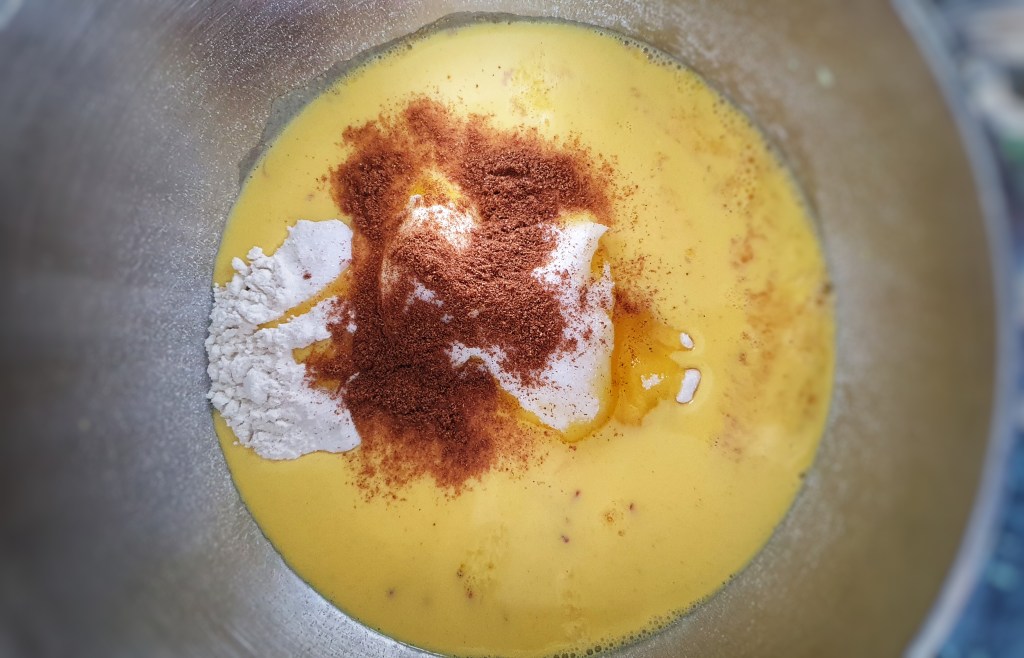
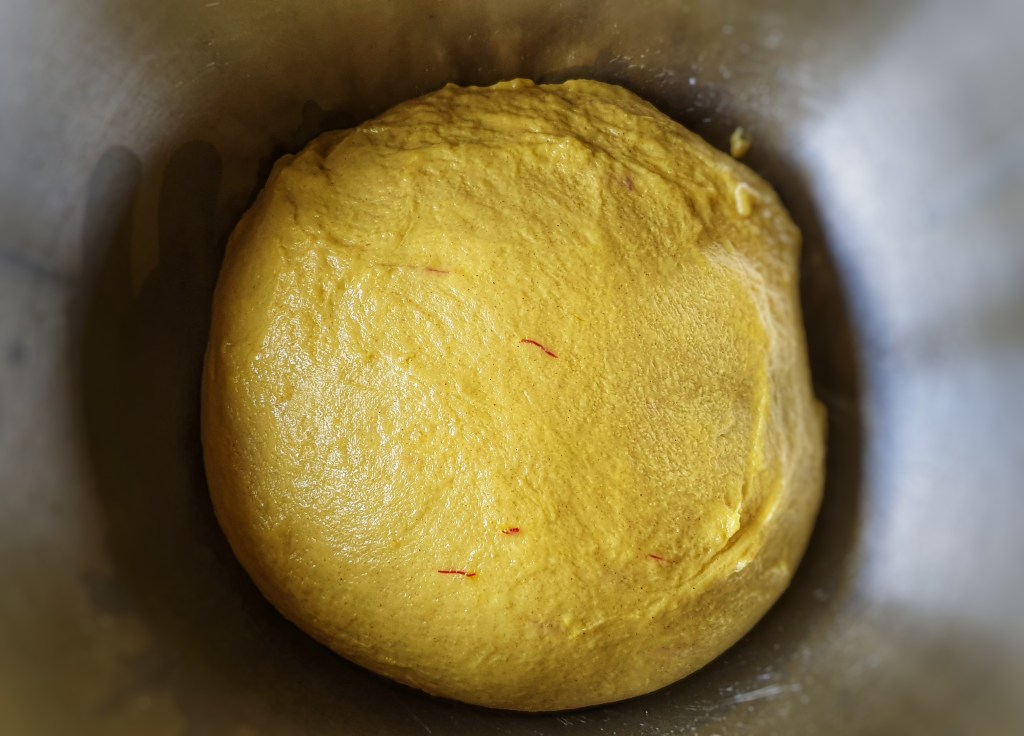


Add a little oil to a bowl and with oiled hands, gather up your dough into a ball and sit it in the bowl. Cover with cling film or a damp, clean tea towel until it doubles in size. Mine took 2 hours.
Knead the dried fruit into the dough, then divide into 12 (for precision weigh the dough), then line a baking tray with greaseproof paper.
Roll each piece of dough into tight balls using a very small amount of flour to prevent it sticking and then arrange on the baking tray. Cover and allow to prove – this usually takes a third of the time as the first rising.[11]
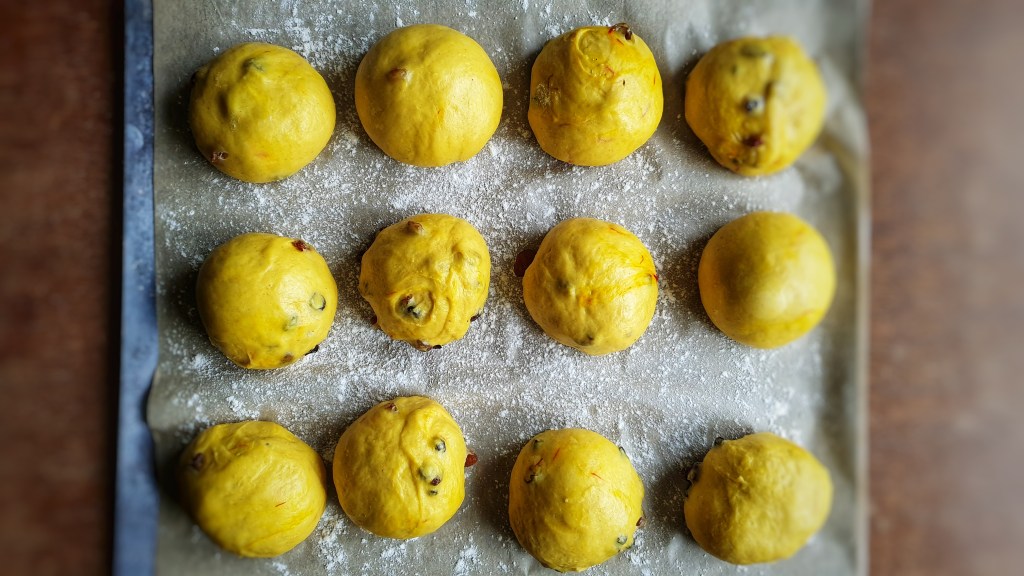

Preheat the oven to 200°C and use the steam setting, or place a metal tray on the base of the oven and pour water into it.
Brush the buns with milk and place in the oven for 18 to 20 minutes. If they turn too golden brown, turn down the heat to 175°C.
When ready, remove from the oven and immediately brush with more milk and then throw a double layer of clean tea towels over them and allow to cool.
These are best eaten on the day they were made; any older than that, they should be toasted.
Notes:
[1] Davidson, A. (1999) The Oxford Companion to Food. Oxford University Press; Mason, L. and Brown, C. (1999) The Taste of Britain. Devon: Harper Press. It also prompts the question – why are there no famous Essex saffron bakes or dishes? Maybe there is.
[2] Bilton, S. (2022) Fool’s Gold: A History of British Saffron. Prospect Books.
[3] Digby, K. (1669) The Closet of Sir Kenelm Digby Opened (1997 reprint). Edited by J. Stevenson and P. Davidson. Prospect Books.
[4] Cassell (1883) Cassell’s dictionary of cookery. Cassell, Petter, Galpin & Co.; Farley, J. (1783) The London Art of Cookery, and Housekeeper’s Complete Assistant. Price.
[5] Mason & Brown (1999); Bilton (2022).
[6] Bilton (2022).
[7] Cassell (1883)
[8] David, E. (1977) English Bread and Yeast Cookery. Grub Street.
[9] Bilton (2022).
[10] I speak from personal experience here: if you don’t remove the skin, the strands just get caught encapsulated in it.
[11] The best things to use to cover a whole tray of buns are a large shopping “bag for life”, an upturned plastic storage box or a damp, clean tea towel: take your pick.
Four Scone Recipes
You know what it’s like; you go to the home baking aisle of the supermarket and pick up a bag of flour, thinking ‘I’m sure I’m running low’, buy a bag, only to find there is, in fact, a large bag sitting, unopened, in the pantry. Unsure what to do with them, I asked social media whether I should make some scones, saffron buns or lardy cake with it (three recipes I have been meaning to post for years now). The answer came in: 3-way tie. I shall endeavour to do all three for you over the next month or so.
Up first, then, are scones, the must-have for a modern Cornish or Devonshire cream tea. I have written about cream teas both on the blog and in my book Knead to Know, the excerpt of which you can find on my YouTube Channel.
This is the recipe I used when I had both my restaurant and artisan market stall, so it is very tried-and-tested. I have provided some variations for you beneath the method: cranberry and orange, cheese, and walnut and Stilton. When the restaurant was open, we served a savoury cream tea using a cheese scone, swapped clotted cream for cream cheese and exchanged the jam for curried beetroot chutney or onion marmalade.
Classic recipes – especially Scottish and Irish ones – use buttermilk instead of plain milk. As buttermilk is increasingly difficult to get hold of these days, I’ve used milk, but you can swap the two. If you do, use 15 g bicarbonate of soda instead of 25 g baking powder. One final thing: I use strong white flour instead of plain to give the scones a boost in the oven, again, not traditional; in fact, it was a trick picked up from Paul Hollywood in his book 100 Great Breads. This doesn’t mean you can knead the dough roughly as though it is for bread; you still have to use a light touch with mixing, rolling and cutting out. Hopefully, my method will help you achieve great results.
I’ll follow soon with a post on the history of scones.
If you like the blogs and podcast I produce and would to start a £3 monthly subscription, or would like to treat me to virtual coffee or pint: follow this link for more information. Thank you.
Basic Scones
A note on measuring liquids: 1 ml of milk weighs 1 g, so it’s easier – and much more accurate – to weigh it on scales rather than reading the graduations on the side of the measuring jug.
Makes 12 to 15 scones.
500 g strong white flour, plus extra for dusting
30g baking powder
½ tsp salt
75g butter
75g caster sugar
80g quartered glacé cherries, raisins or currants (optional)
200 ml/g whole milk
2 medium eggs
Egg wash: 1 egg or egg yolk beaten with ½ tsp salt
Granulated or Demerara sugar for sprinkling
Preheat your oven to 200°C.
In a bowl, mix flour, baking powder and salt and rub in the butter – you can use the flat beater attachment on your mixer with this, or good old fingertips. Stir in the sugar and fruit (if using).
Beat the eggs with the milk, and steadily mix the liquids into the dry ingredients. If using a mixer, keep it at a slow speed. Make sure all the flour is incorporated, bring the dough together and give it a brief knead on a floured worktop until the dough is smooth.
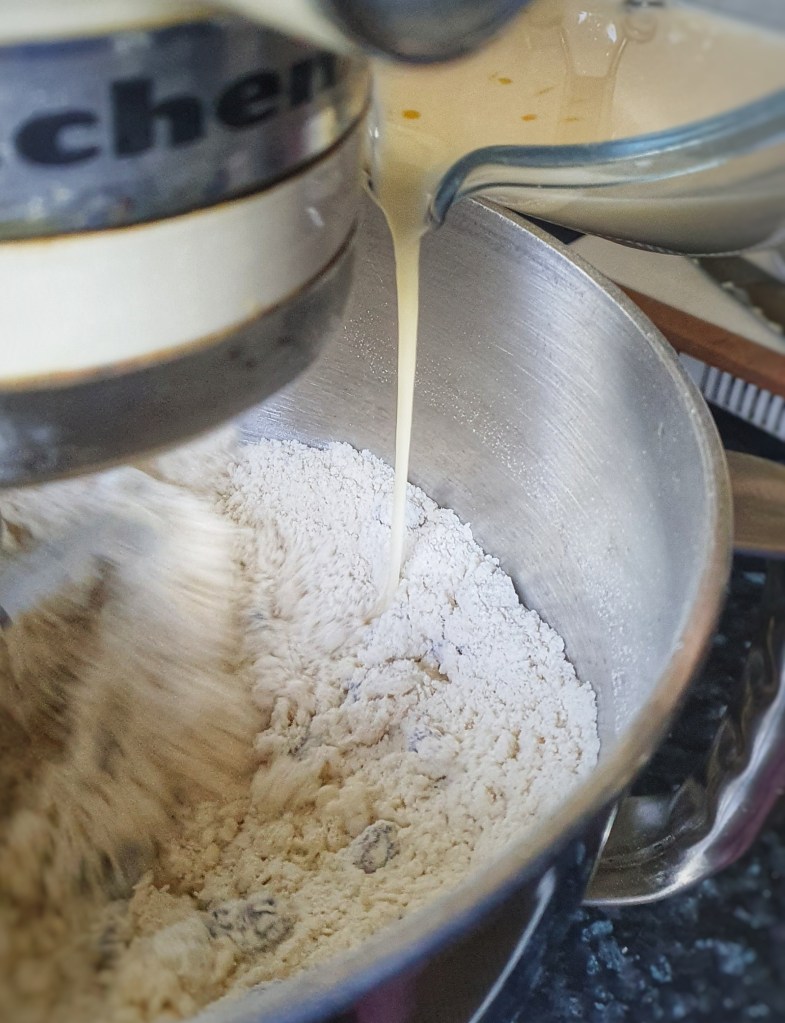
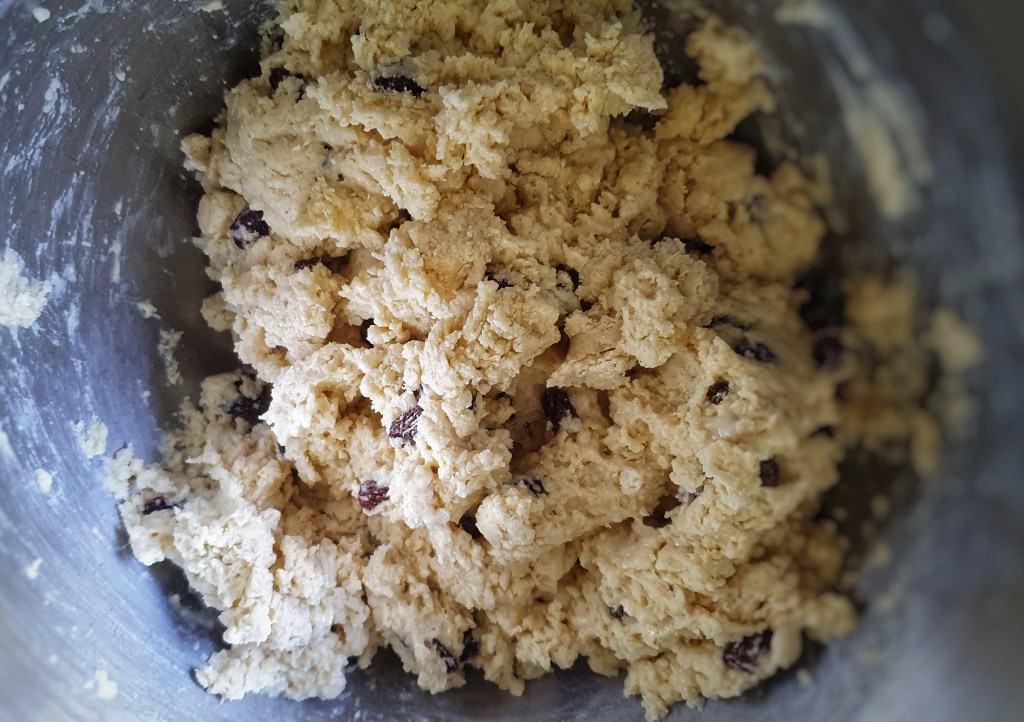

Keeping your worktop floured, roll out the dough to a thickness of 1.5 to 1.75 cm (a generous ½ inch), and cut out into rounds. I normally use a cutter of a diameter between 7 and 8 cm. It is important to take care when cutting: make sure you dunk your cutter in more flour and tap off excess before cutting. This is important because if there are splodges of sticky dough on the cutter, it will seal the edges of the scones, preventing a good rise. Also, don’t be tempted to twist your cutter, as this will have a similar effect. Arrange the cut-out scones on 2 lined baking sheets.

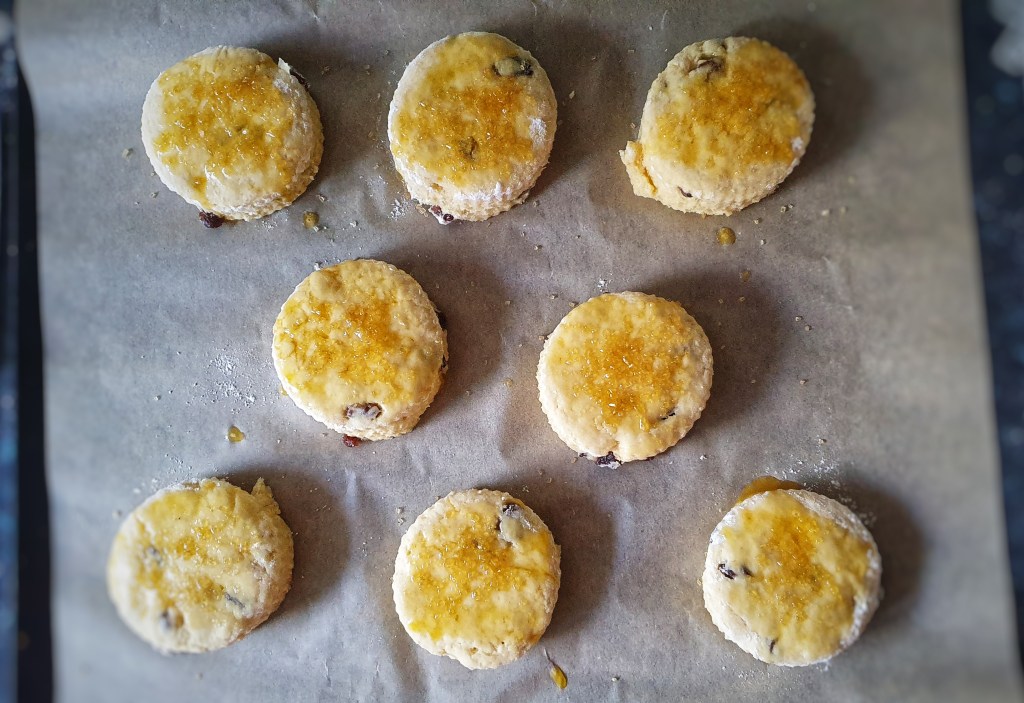
Bring the leftover dough together with your hands to form a cohesive dough without kneading it too much – we don’t want tough scones! Roll out again and cut out. Repeat until all of the mixture is used up.
Brush with egg wash being careful not to let any dribble down the sides – again, this will hamper the rising of the dough – then sprinkle with sugar. Bake for 15-20 minutes until golden brown and well risen. If there is uneven browning at the 10-minute mark, switch the trays around in the oven.
Cool on a rack.
Scones are best enjoyed on the day or the day after they are made. They do freeze well. Enliven them by popping them in the microwave for 10 to 20 seconds.
Eat with butter or clotted cream and jam.
Variations
Cranberry and Orange
Make as above, but add the zest of two oranges to the dry ingredients, and use dried cranberries instead of raisins or currants. Juice the oranges, pour into a measuring jug and top up with milk to 200ml/g.
Classic cheese scones
Use just 25 g caster sugar, and add 100 to 125 g grated Cheddar cheese once the flour has been rubbed in. If you like, you can add ½ teaspoon of dried herbs and a good pinch of Cayenne pepper. Use 230 g/ml of milk instead of 200 g/ml. Sprinkle some finely grated cheese (Parmesan is good) over the egg-washed scones before they go in the oven.
Walnut and Stilton scones
As above, but use 100-125 g grated Stilton and 80 g chopped walnuts
Yorkshire Teacakes
A hospitable Yorkshire housewife would consider her tea table was barely spread if it were not liberally supplied with these delicious cakes, constant relays of which should be served steaming hot.
Cassell’s Dictionary of Cookery (1883)[1]
A split and toasted fruit teacake, liberally spread with melting salted butter is one of life’s simple pleasures. For those of you who are not already in the know, a Yorkshire teacake is a round, slightly flattened, enriched, soft breadcake usually containing a little sugar, spice, dried fruit, and candied peel. There was a time when England had scores of regional fruited or enriched bread cakes and loaves, but they have largely gone by the wayside. Others that spring to mind are Bath buns, Wiltshire lardy cakes and Lincolnshire plum bread.[2] These types of cakes and breads are much more appreciated in Wales, Scotland and Ireland, or so it seems. The Yorkshire teacake has escaped its regional roots, so much so that it has lost its Yorkshire identifier and is simply called a teacake by most people.
Yorkshire teacakes can be traced back to the opening decades of the 18th century when they were called ‘Yorkshire Cakes’. They will have been very expensive because they are enriched with eggs, butter, milk, and plenty of sugar and dried fruits.[3] By the 1880s, they are called Yorkshire teacakes.[4]
Working-class families enjoyed them too, but there was invariably less fruit, just a touch of sugar, half-and-half milk and water, no eggs and lard instead of butter. I like this more austere version, though I do go will all milk (full fat, of course) and much prefer lard to often over rich butter. Looking through recipes, the amount of lard varies greatly from a knob to over five ounces per pound of flour.
It’s very important that the teacakes are nice and soft. To achieve this, heed this excellent advice from Florence White:
Immediately after taking from the oven, rub over with buttered paper, and cover with a light, clean blanket; this gives a soft skin.[5]
When they are freshly baked they are lovely eaten untoasted, but any older than that and they must be split and toasted (or if you want to go hardcore Yorkshire, strong Cheddar cheese[6]).
It occurred to me that I hadn’t baked a batch of teacakes for a good few years, and I was thereafter craving them, so I baked a batch. They are so worth making at home and I give you my recipe, should you fancy having a go yourself.
If you like the blogs and podcast I produce and would to start a £3 monthly subscription, or would like to treat me to virtual coffee or pint: follow this link for more information. Thank you.
Recipe
This is quite a sticky dough and I would recommend making this in a stand mixer with a dough hook, but they can be made without one; just be prepared to be very sticky in the first 10 minutes of kneading. If you prefer plain teacakes, omit the fruit and spice and add half the sugar.
Makes 8 teacakes:
500 g strong plain flour, plus extra for kneading and shaping
30 g caster sugar
1 tsp salt
1 tsp instant yeast
½ tsp mixed spice or ½ a grated nutmeg
80 g softened lard or butter, or a mixture
300 ml warm milk or half-and-half milk and water
Around 2 tbs vegetable or sunflower oil
80 g mixed dried fruit
30 g candied peel (optional)
Extra milk for brushing
Add the flour, sugar, salt, yeast and spices to a mixing bowl, make a well in the centre and add the softened fat, then tip in the warm liquid. Using a kneading hook, mix the ingredients on a slow speed until everything has combined, then turn up the speed a notch or two and knead for about 10 minutes until smooth – it won’t be very elastic because of the lashings of lard.
If you want to do this by hand, mix the ingredients with a wooden spoon. When thoroughly mixed, leave it to stand for 15 minutes or so; this gives the flour to absorb some of the liquid making for easier hand kneading. Knead on a lightly floured surface for around 15 minutes.
Brush a clean mixing bowl with the vegetable oil, gather up the floppy dough as best as you can (oil your hands, it makes this bit much easier), tuck it into a ball and pop it in the oiled bowl. Cover with a tea towel or cling film until it has doubled in size. This will take a while; even sat close to the radiator, my dough took over two hours.
Now take two baking sheets and line them with greaseproof paper and set aside.
Tip the dough onto a floured worktop and press out into a square, add the fruit and knead it into the dough. You do this step in the oiled bowl if you like. When everything is reasonably equally distributed, cut the dough into 8 equal-sized pieces. Using just a very little flour roll the pieces of dough into tight balls, then roll them out into circles with a floured rolling pin so they are 4 to 5 cm thick. Sit them on your baking sheets as you make them.
When you’ve done all 8, cover them with tea towels or place a container over them so they can prove again. In my experience the second proving takes about half the time of the first. As they prove turn your oven to 200°C fan (or equivalent). If you have a steam setting on your oven, use it. If you don’t, place a roasting tin in the bottom of the oven to heat up, and when you put your teacakes in the oven, tip some water into the now very hot tin and close the door.
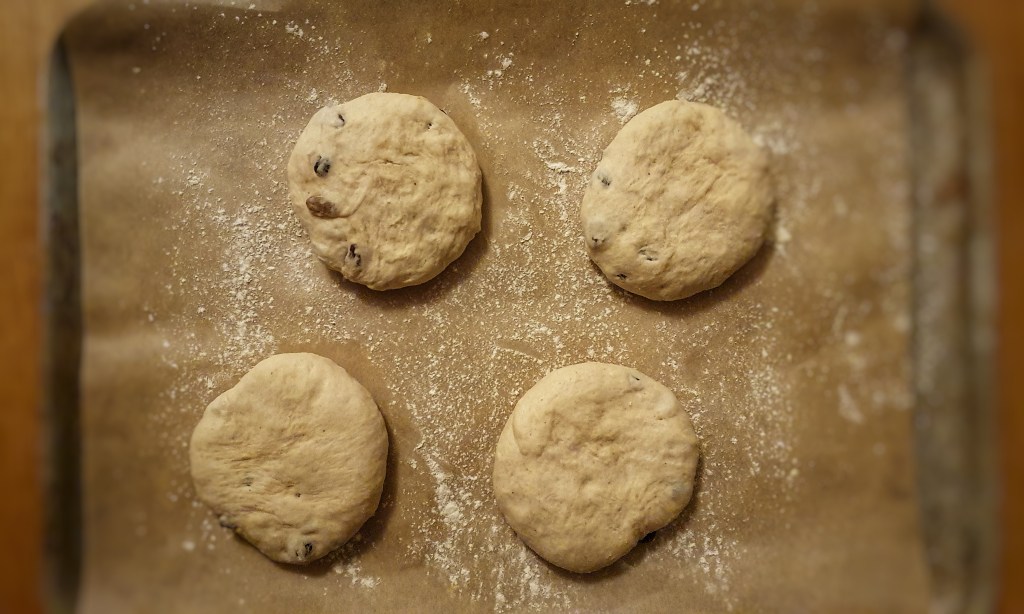
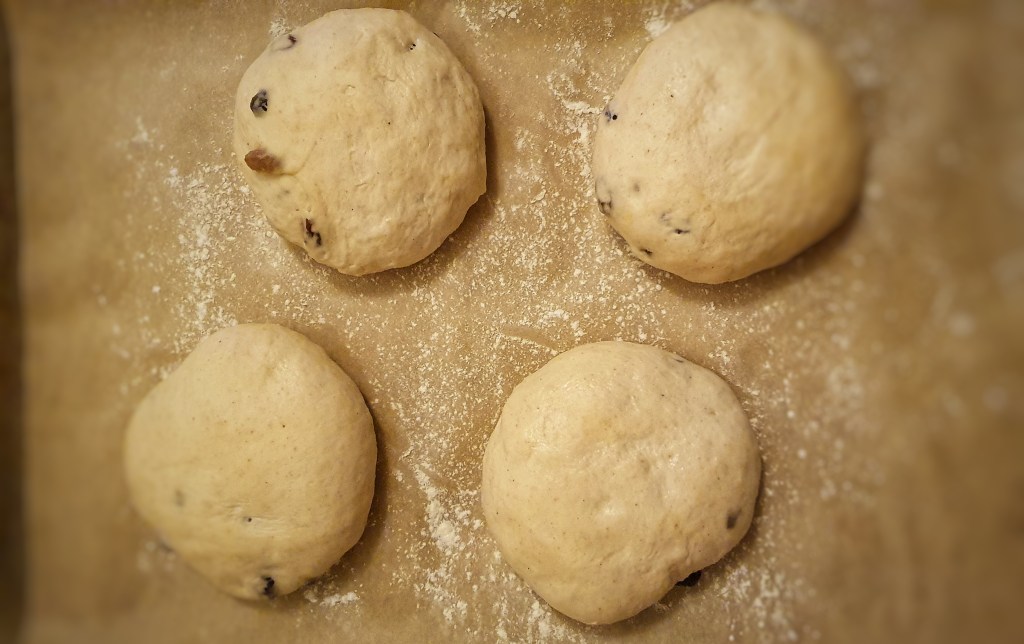
When they have doubled in size, brush them with milk and pop them in the oven. Bake for 15 to 20 minutes until golden brown. Test whether they are ready by tapping the base of one: it should sound hollow.
Remove the teacakes from the oven and immediately throw a double layer of tea towels over them to keep them soft as they cool.
Notes:
[1] Cassell (1883) Cassell’s dictionary of cookery. Cassell, Petter, Galpin & Co.
[2] Check out Elizabeth David’s classic English Bread and Yeast Cookery (1977) for several other examples.
[3] David, E. (1977) English Bread and Yeast Cookery. Grub Street; Mason, L. and Brown, C. (1999) The Taste of Britain. Devon: Harper Press.
[4] Cassell (1883)
[5] White, F. (1932) Good Things in England. Persephone.
[6] Brears, P. (2014) Traditional Food in Yorkshire. Prospect Books.
To make a Bakewell tart
At the end of 2024, I gave you my recipe for Bakewell pudding. The plan was to follow with my recipe for Bakewell tart. Alas, life, Christmas and then a holiday to New Zealand got in the way.
But I always get around to things eventually and I give it to you today!
The Bakewell tart, despite it being dearly loved by Brits, was originally made as a cheap, dumbed-down version of the rich Derbyshire pudding: the puff pastry swapped for shortcrust, and the buttery almond filling swapped for an almond-flavoured sponge cake.
I write about the histories of the Bakewell pudding and tart in Knead to Know: A History of Baking, so pick up a copy if you want to know more.
I have been using this recipe for years now and it’s a real crowd-pleaser. When the restaurant was open, I served this tart warm with a lemon-flavoured cream and received a big bear hug from a diner: there could have been no better seal of approval in my book! The secret to its success is that I make a frangipane rather than a sponge cake filling, bound together with just a tablespoon of flour.
If you like the blogs and podcast I produce and would to start a £3 monthly subscription, or would like to treat me to virtual coffee or pint: follow this link for more information. Thank you.
Recipe
Makes 1 x 21 cm/8 inch tart
For the sweet shortcrust pastry:
200 g plain flour
100 g salted butter, diced (or half-and-half butter and lard)
50 g caster or icing sugar
1 egg, well beaten
Cold water (see recipe)
For the filling:
100 g salted butter, softened
100 g caster sugar
2 eggs
100g ground almonds
30 g self-raising flour
¼ tsp almond extract
3 or 4 tbs raspberry jam
30 g slivered almonds
First, make the pastry: Place the flour and fat(s) in a mixing bowl and rub the fat in until the mixture resembles fresh breadcrumbs. You can do this by hand using fingertips or with the flat beater of a stand mixer on a slow speed. Make a well in the centre and add most of the egg. If using a stand mixer, slowly mix it in, pouring more egg into any dry patches. If doing by hand, use a butter knife to mix (this prevents overworking of the dough). You should have a cohesive dough that can be brought together with your hand – if it does seem dry, add a tablespoon of cold water.
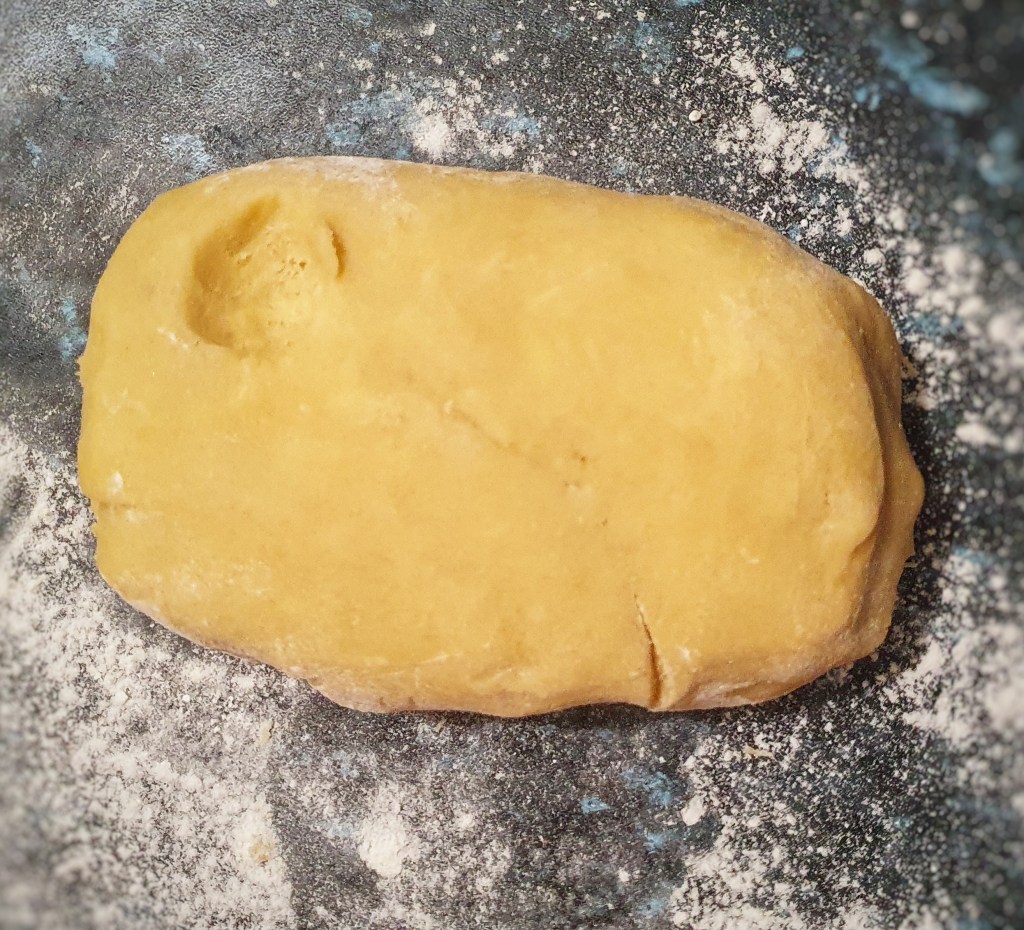
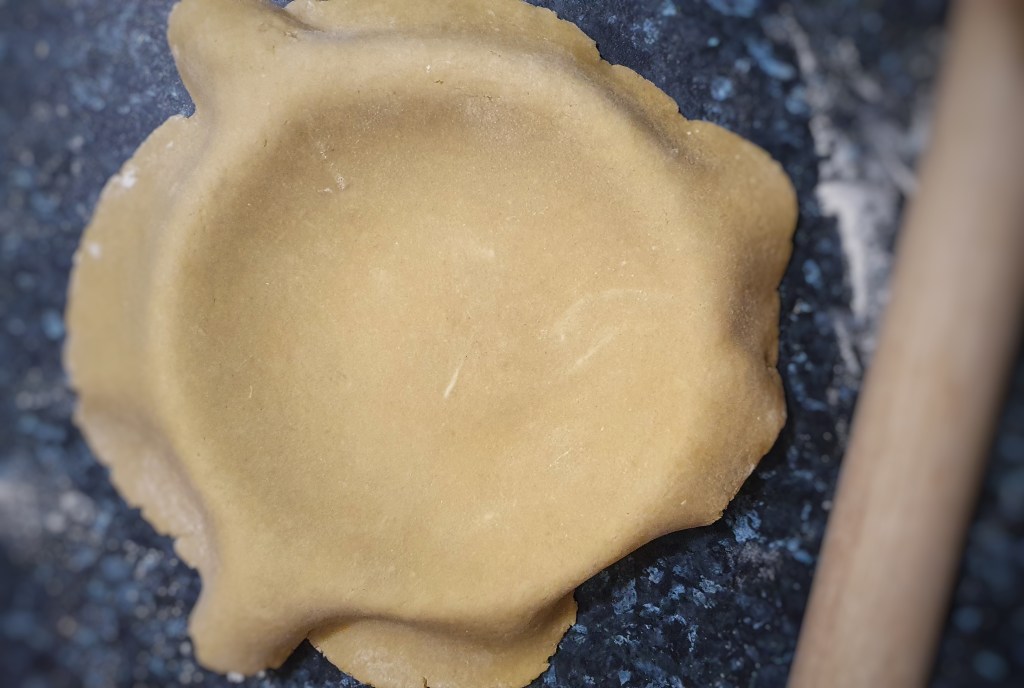
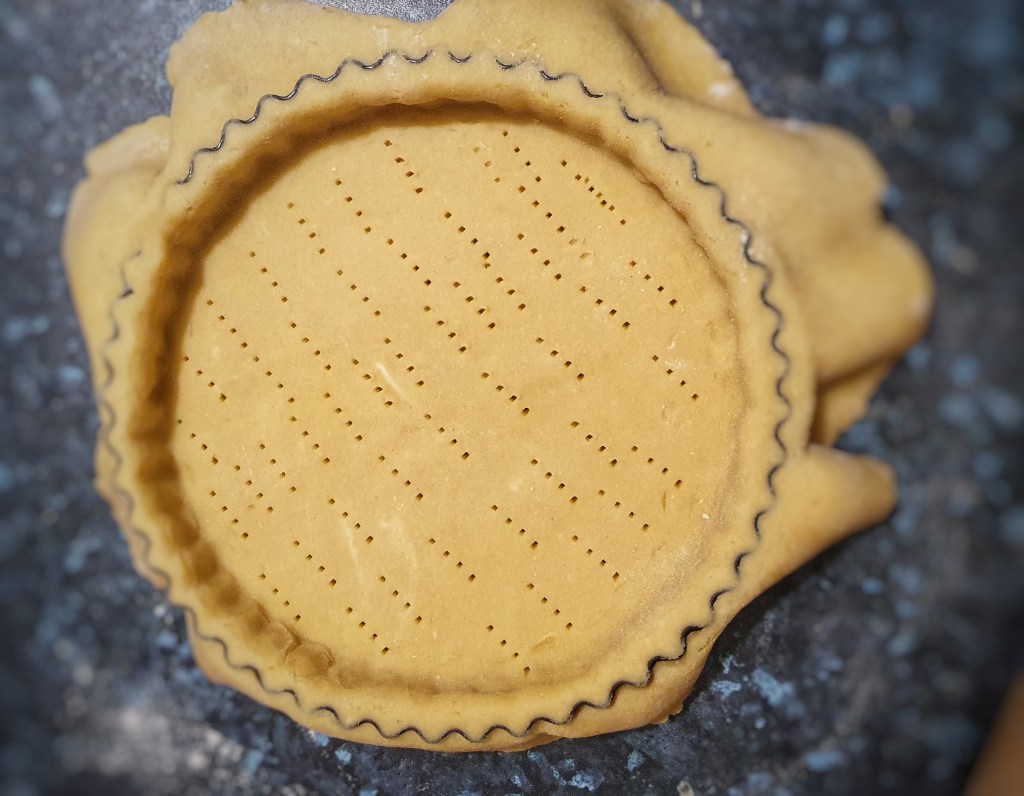
Knead briefly, cover and allow to rest in the fridge for 20 to 30 minutes. Meanwhile, preheat your oven to 180°C and place a baking tray on the centre shelf
On a lightly floured work surface, roll out the pastry to the thickness of a pound coin, and use it to line an 8”/20 cm loose-bottomed tart tin or ring.[1] Prick the base with a fork and place it back in the fridge to firm up.
Now make the filling: using a hand beater or stand mixer, beat together the soft butter, caster sugar, eggs, almonds, flour and extract until smooth.
Take the pastry out of the fridge and spread jam over the bottom leaving a centimetre gap all around the inside edge. Spoon or pipe the mixture first around the edges and then the centre (this stops the jam from rising up the sides of the pastry lining), levelling off with a spatula.
Sprinkle with the slivered almonds and slide the tart onto the hot baking sheet and bake for 40 minutes, turning the heat down to 160°C if the top gets too brown. Cool on a rack, and remove from the tin when just warm.
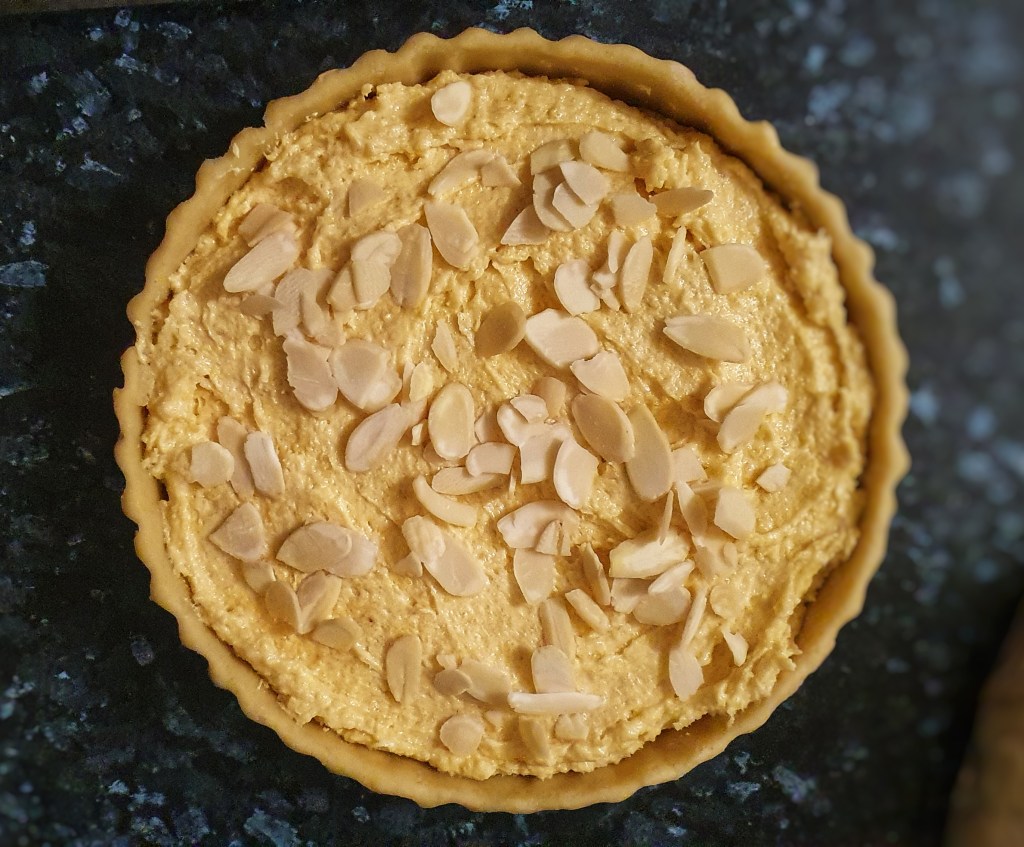
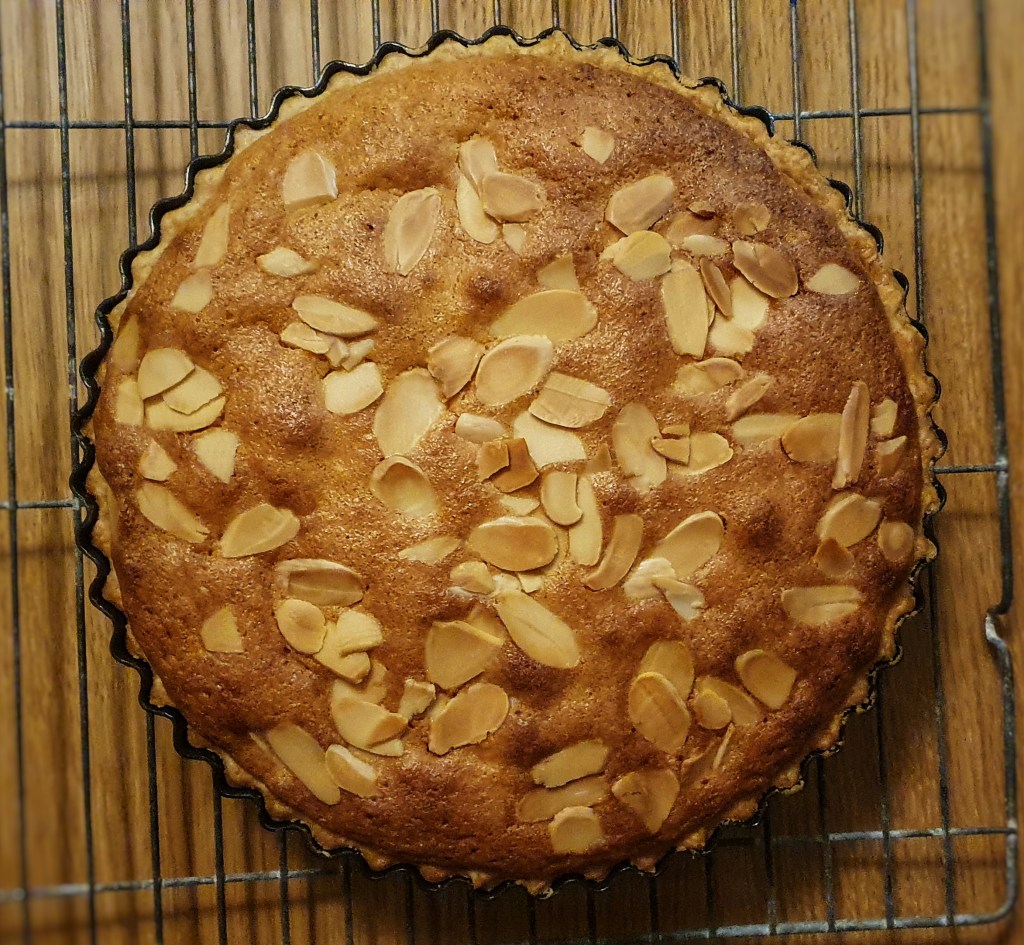
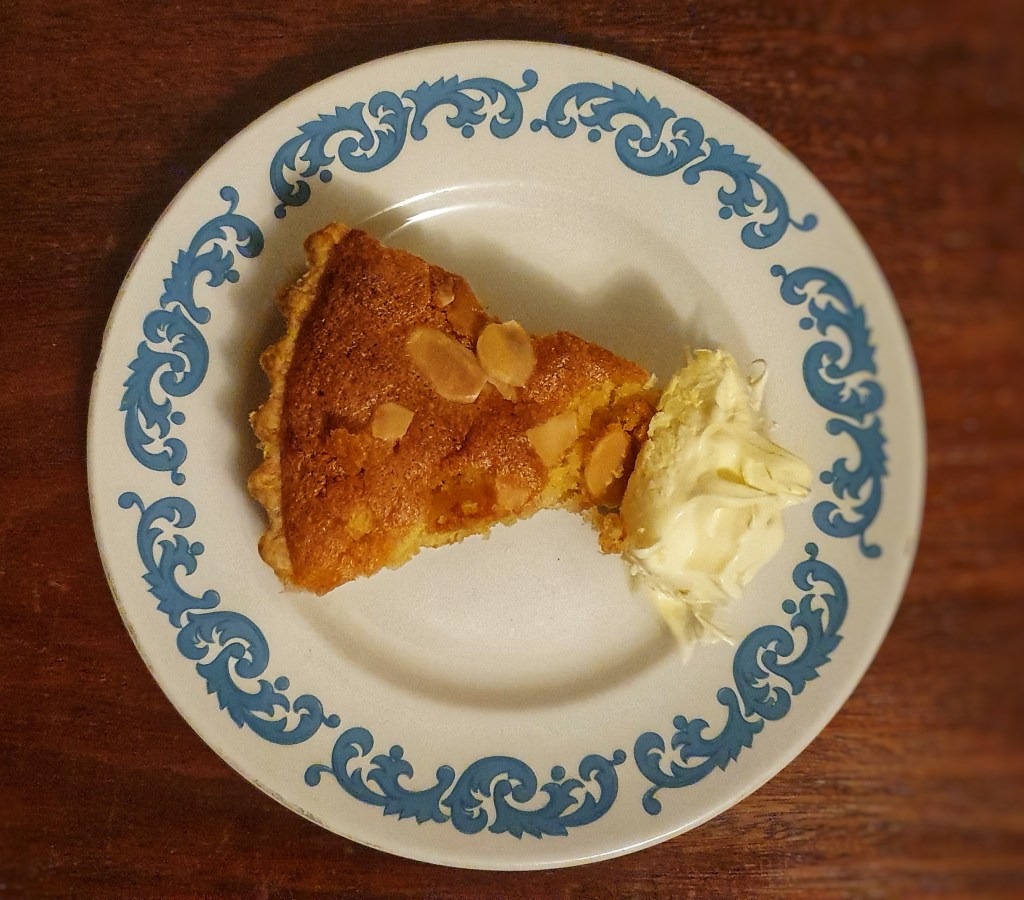
[1] You will find that there is excess pastry – make some nice jam tarts or turnovers.
Irish Coffee
Merry Christmas everyone! It’s time for my annual Christmas boozy drink recipe, and this year I’m going with a classic Irish coffee. Many have been made and drunk in the Buttery household over the last couple of weeks: all in the name of research, you understand.
The Irish coffee was invented soon after the end of World War Two in 1945; transatlantic flights had just recommenced and there were flights from the US full of visiting dignitaries landing at Shannon airport. Chef Joe Sheridan was tasked with making a special drink for the travellers that was comforting and evocative of Ireland’s warm hospitality. He came up with a ‘Gaelic coffee’, a mixture of whiskey, brown sugar cubes, hot coffee and cream. It was a great success and was given to all travellers landing at Shannon Airport thereafter.[1]
In the 1950s, the drink, now called Irish coffee, was taken to the USA where it was made bigger and sweeter, and sugar syrup replaced sugar cubes.[2]

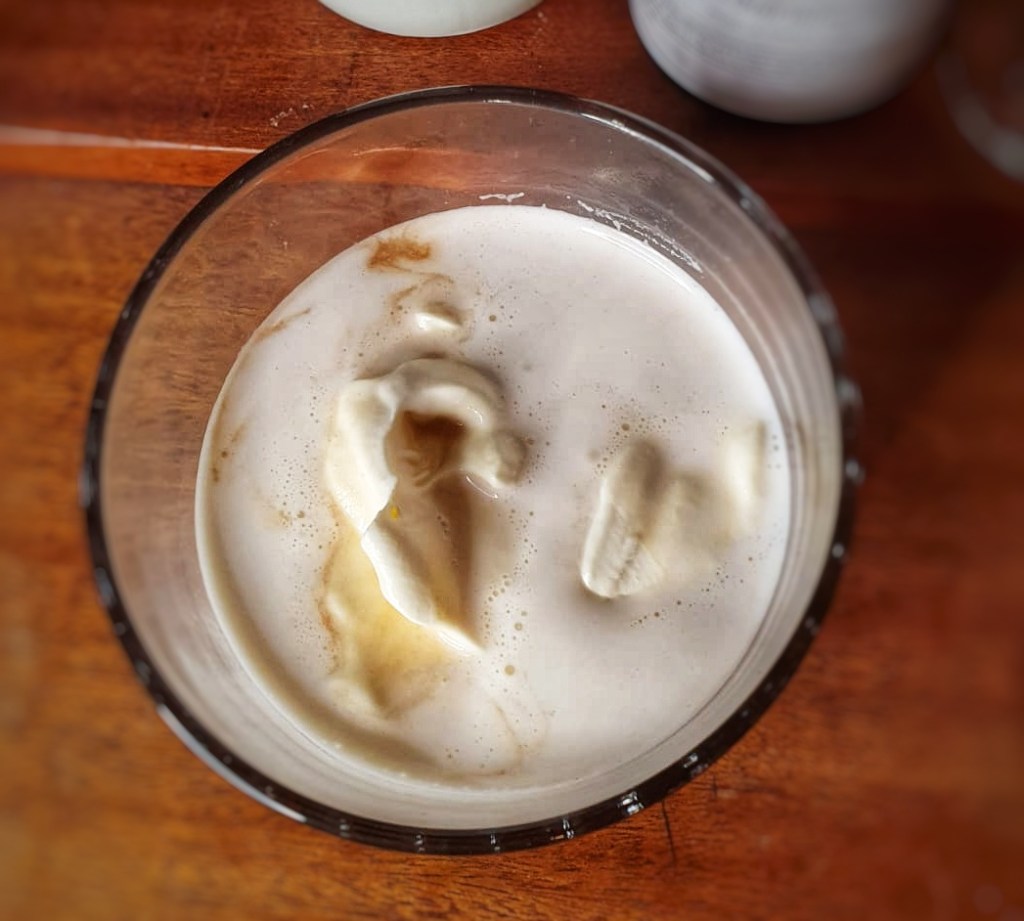
From a personal point of view, I have great memories of going to a lovely little Indian restaurant with my parents in Pudsey, West Yorkshire in my late teens. We always ended our meal with one of their delicious Irish coffees. It didn’t occur to any of us to ask why an Indian restaurant in Yorkshire was serving Irish coffee.
This recipe is based on the one provided by Matthew Roberston in the excellent Cocktail Bible.[3] (Robertson, 2018) It’s made extra special with the inclusion of a dash of coffee liqueur and a sweetening of vanilla syrup, though you could just use regular sugar syrup and miss out the liqueur. I think one shot of syrup is too much, though not everyone in the family agreed with me on that one, so add to taste.
If you like the blogs and podcast I produce and would to start a £3 monthly subscription, or would like to treat me to virtual coffee or pint: follow this link for more information. Thank you.
Per person:
1 ¾ shots Irish whiskey
2 shots espresso, or very strong coffee
½ shot coffee liqueur such as Kalua
½ to 1 shot vanilla or sugar syrup
2 good tablespoons of lightly whipped double cream
Warm all of the ingredients, except the cream, in a saucepan until they just begin to simmer—don’t boil it hard, as you’ll lose much of the alcohol!
Pour into a small glass such as a rocks glass and spoon over the floppily-whipped cream; as it melts it will form a delicious layer of cream.
Notes:
[1] MacMahon, J. (2024) An Irish Food Story: 100 Foods That Made Us. Nine Bean Rows; Wondrich, D. and Rothbaum, D. (eds) (2021) The Oxford Companion to Spirits and Cocktails. Oxford University Press.
[2] Wondrich and Rothbaum (2021)
[3] Robertson, M. (2018) The Cocktail Bible. Hamlyn.



